A parterre garden offers a timeless way to introduce structure, elegance, and formal beauty into your landscape. Originating in 15th-century France, these gardens are characterized by their symmetrical, ornamental beds, traditionally edged with low, clipped hedges and filled with flowers, herbs, or colored gravel. The patterns are designed to be appreciated from an elevated viewpoint, such as a terrace or an upper-story window, creating a living work of art. Whether you have a grand estate or a small courtyard, these designs can be adapted to suit any space, providing year-round interest and a sophisticated framework for your planting schemes.
1. Classic Boxwood Hedge Parterre Garden
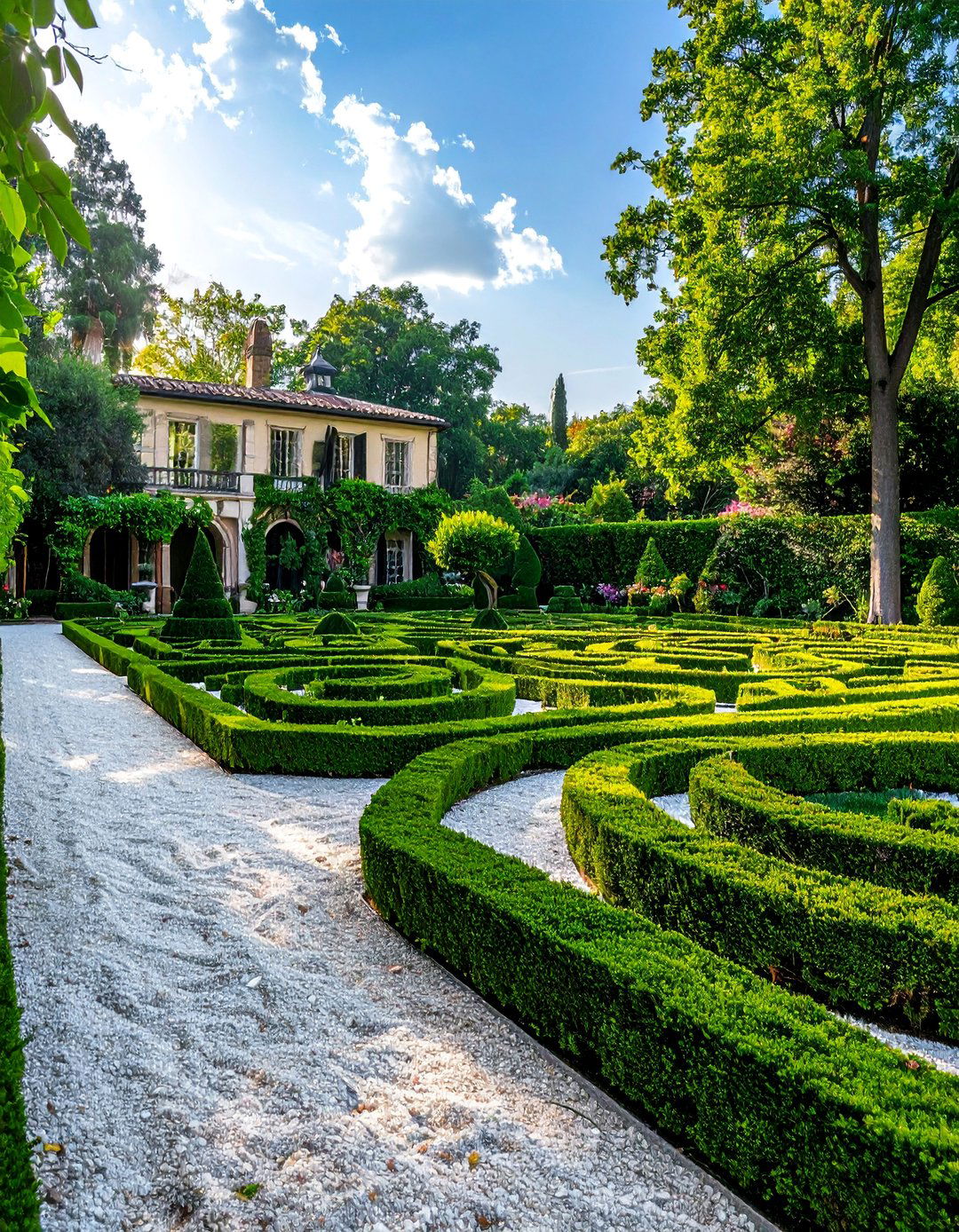
The quintessential parterre garden idea involves using clipped boxwood hedges to create intricate, symmetrical patterns. This classic approach relies on the clean lines and deep green foliage of boxwood to form elaborate scrolls, diamonds, or squares. These compartments are typically filled with contrasting materials like white gravel, crushed shells, or low-growing, colorful annuals to make the green patterns pop. This design works exceptionally well in formal settings, providing a strong architectural backbone to the landscape that remains visually striking even in winter. The precision required for trimming the hedges is key to maintaining the sharp, defined look that makes this style so enduringly elegant.
2. Symmetrical French Parterre Garden
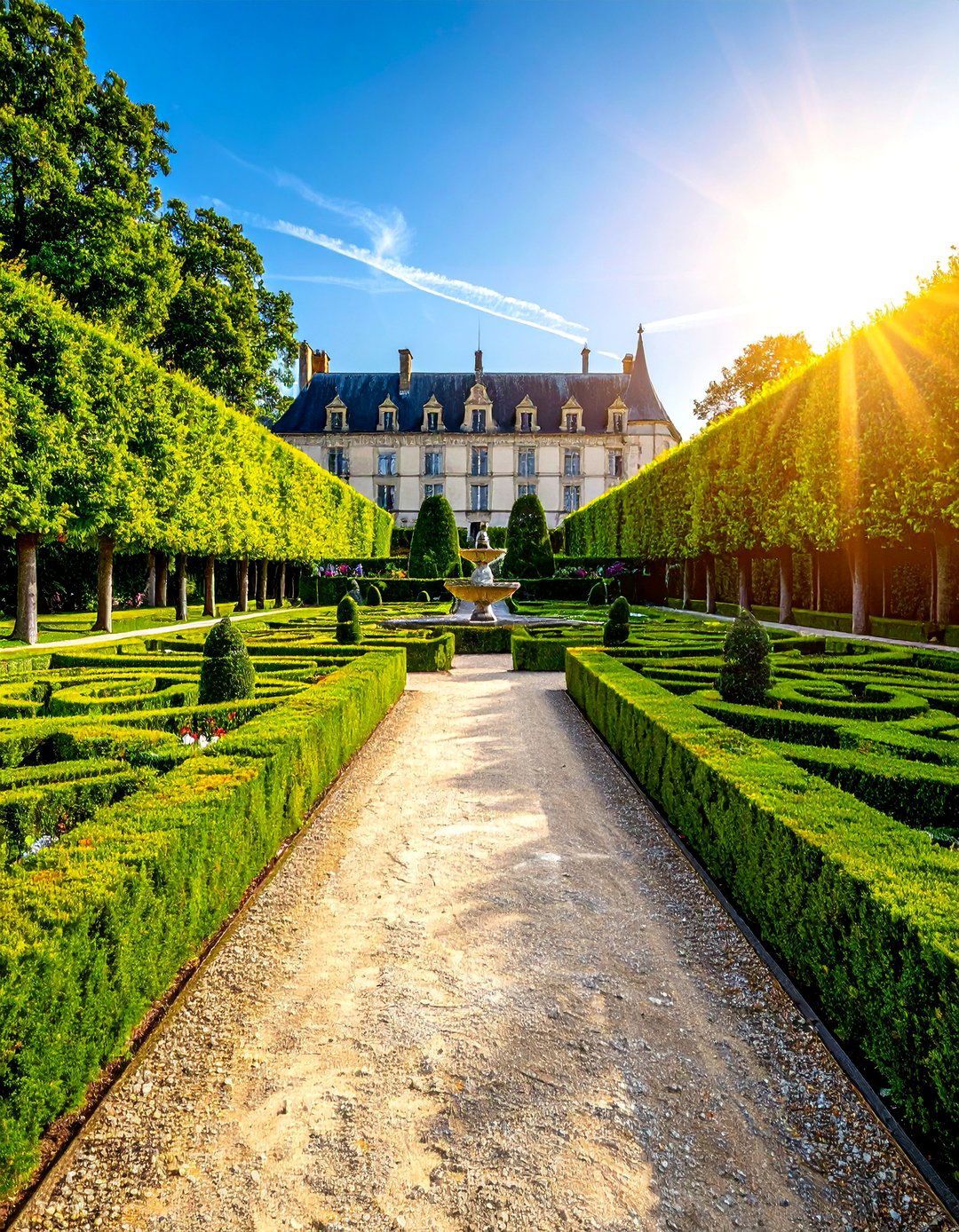
For a truly formal and grand statement, a symmetrical French parterre garden is the pinnacle of landscape design. This style emphasizes perfect balance, with identical patterns mirrored across a central axis, often leading to a focal point like a fountain, statue, or urn. Low evergreen hedges, such as yew or boxwood, are meticulously clipped to form elaborate, flowing patterns reminiscent of embroidery (parterre de broderie). The spaces within the hedges are filled with monochromatic flowers or colored gravel to enhance the intricate design. This approach transforms a garden into a masterpiece of order and harmony, best viewed from an elevated position to fully appreciate its scale and precision.
3. Herbaceous Knot Parterre Garden
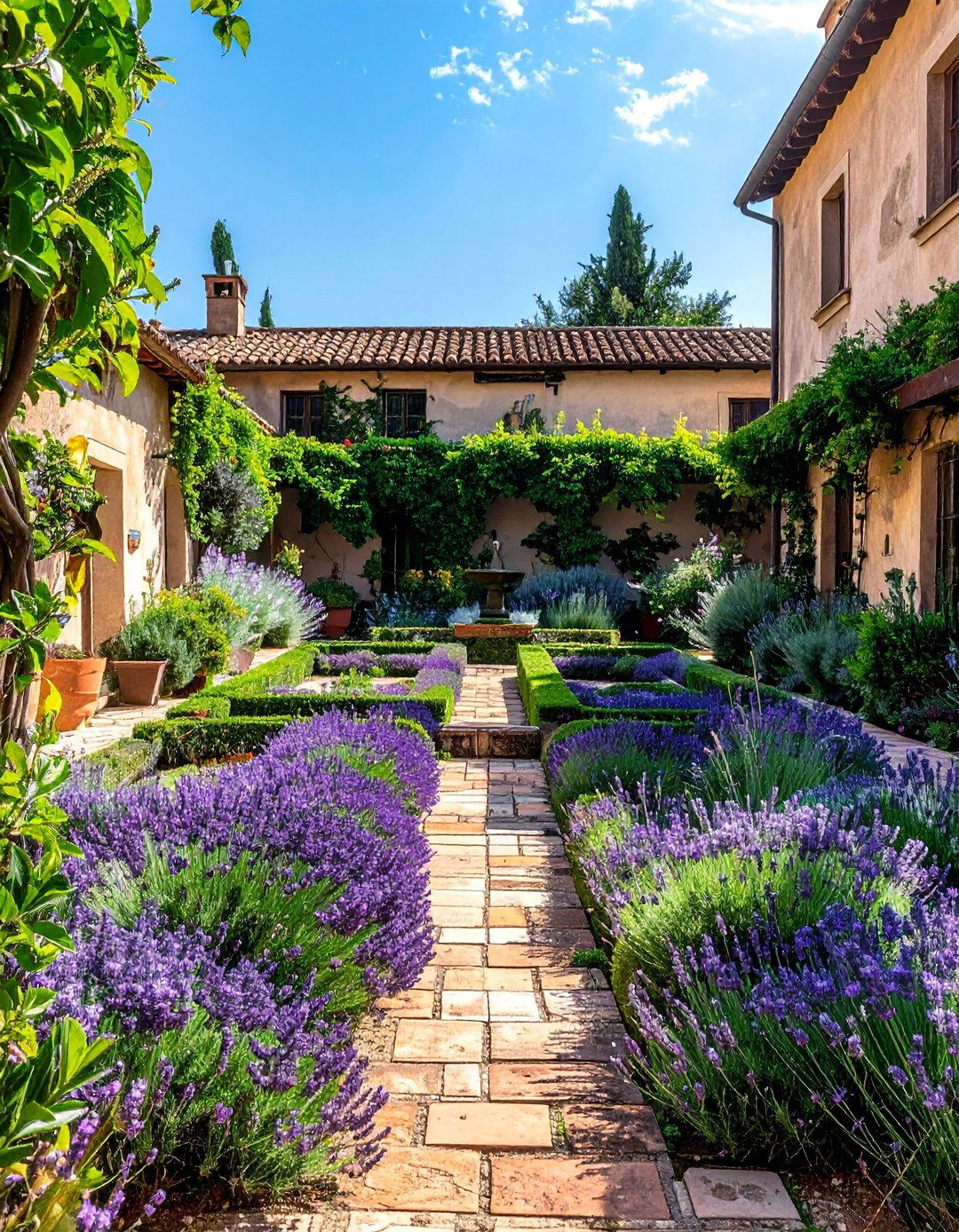
An herbaceous knot parterre garden weaves together different types of aromatic herbs to form an intricate, interlaced pattern. Unlike traditional parterres that use woody hedges, this design uses herbs like lavender, rosemary, thyme, and santolina. The varying colors and textures of the herbs create a living tapestry that is both beautiful and fragrant. The design appears as if the lines of herbs are weaving over and under each other, creating a classic knot effect. This style is perfect for a kitchen garden or a sensory garden, providing visual appeal while also supplying fresh herbs for culinary use, making it as practical as it is ornamental.
4. Edible Vegetable Parterre Garden
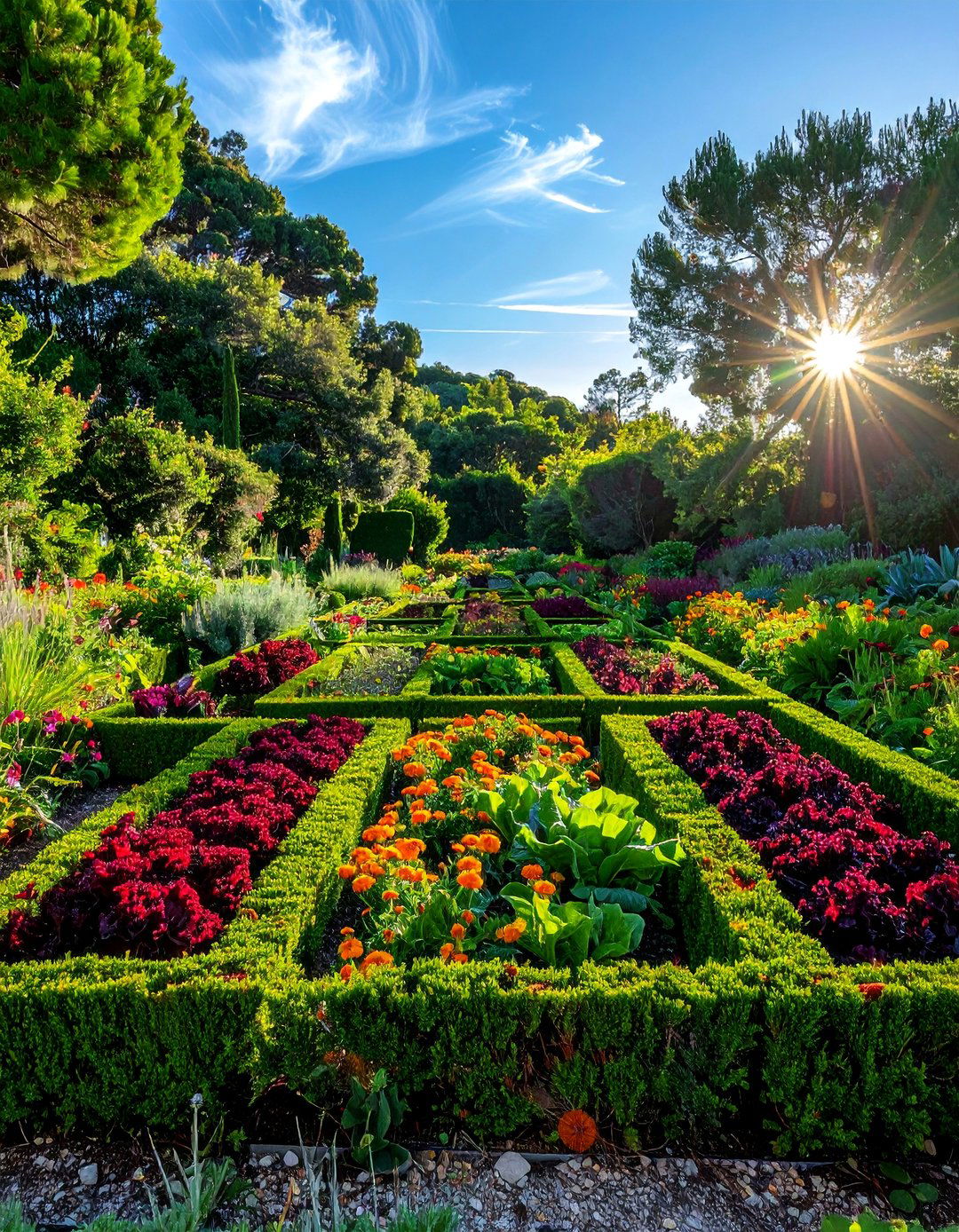
Transform your vegetable patch into an ornamental feature with an edible parterre garden. This clever design, often called a potager, uses the structure of a formal parterre to organize vegetables, herbs, and edible flowers. Low hedges of clipped boxwood or herbs like rosemary can define the geometric beds, which are then filled with colorful lettuces, chard, kale, and companion flowers like marigolds. This approach not inly maximizes growing space but also creates a visually stunning and productive garden. It proves that practical food cultivation can be seamlessly integrated with elegant landscape design, offering beauty for the eyes and a harvest for the table.
5. Rose-Filled Parterre Garden
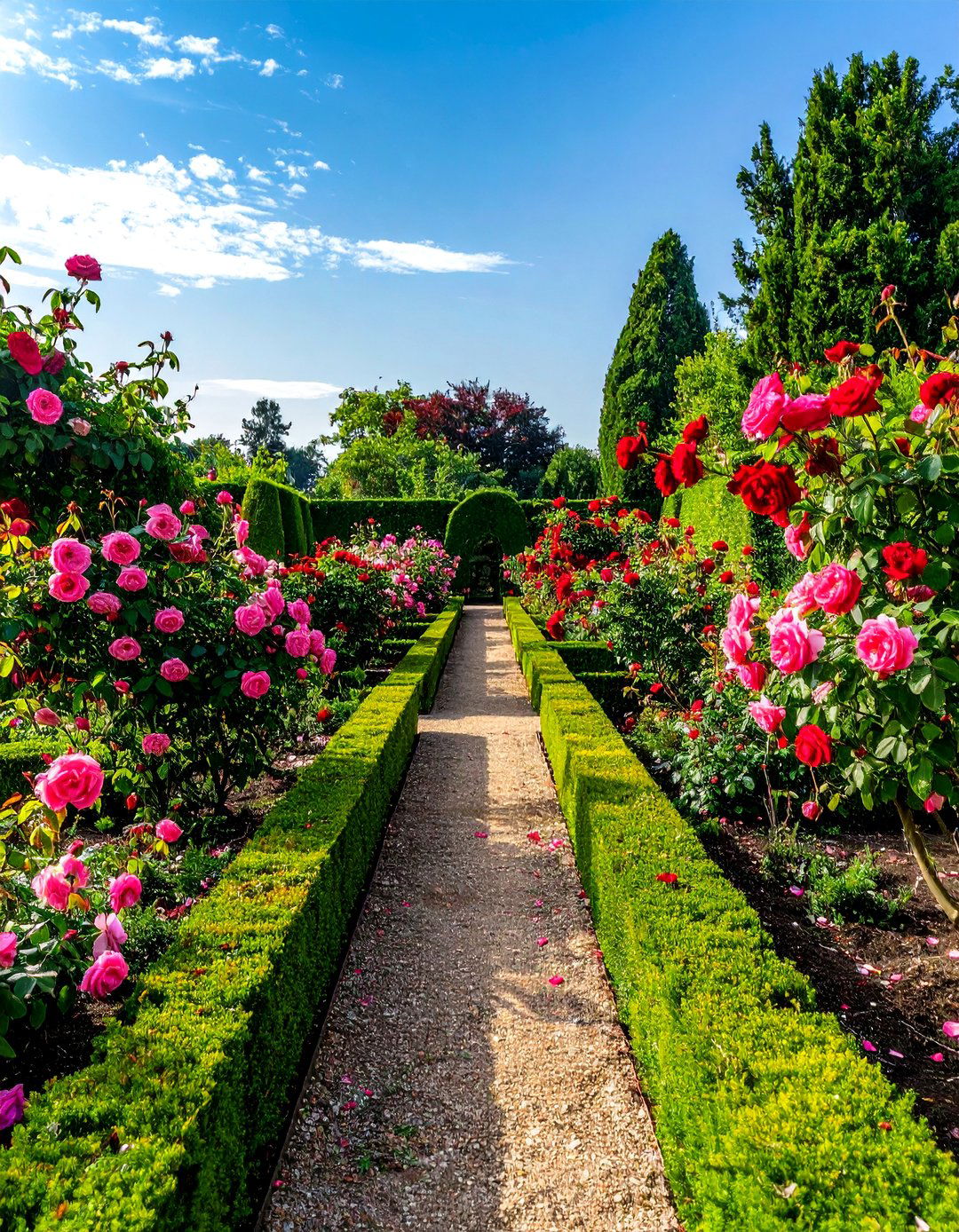
A rose-filled parterre garden combines the formal structure of clipped hedges with the romantic abundance of roses. Low boxwood or lavender hedges create the geometric framework, and the compartments within are mass-planted with a single variety or a complementary mix of roses. This design provides a stunning contrast between the sharp, green lines of the hedges and the soft, colorful blooms of the roses. It offers a continuous display of color and fragrance throughout the blooming season. The formal structure helps contain the sometimes unruly growth of roses, creating a look that is both disciplined and lush, perfect for a romantic or cottage-style landscape.
6. Gravel and Stone Parterre Garden
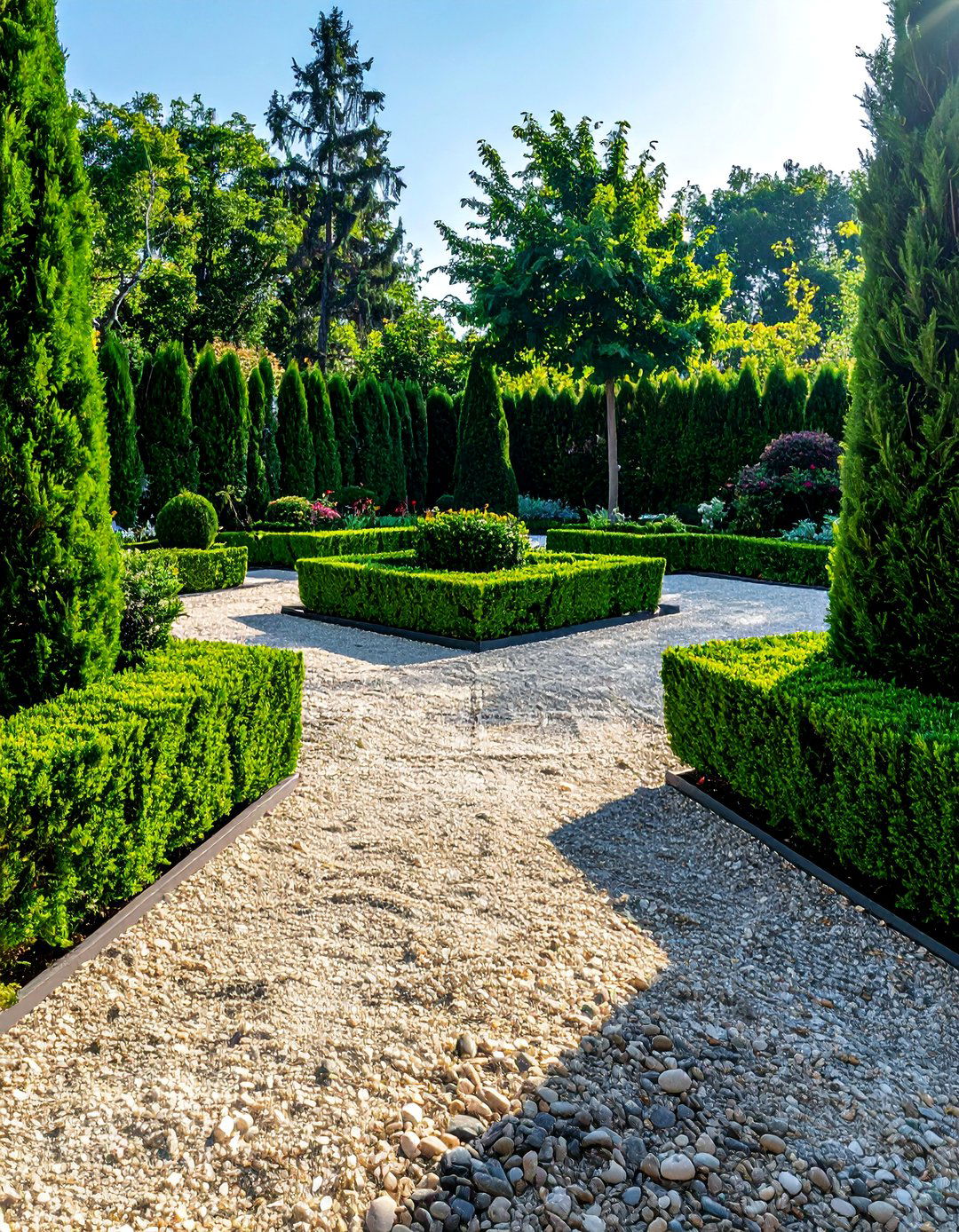
For a low-maintenance yet highly graphic option, a gravel and stone parterre garden is an excellent choice. This design relies on the patterns created by hedges, but instead of flowers or grass, the internal beds are filled with different colors and textures of gravel, stone, or sand. You can create intricate mosaics or simple, bold geometric shapes. This style is particularly effective in arid climates or for homeowners seeking a water-wise landscaping solution. The contrast between the green hedges and the neutral tones of the stone creates a clean, modern, and sophisticated look that provides year-round interest without the need for constant watering or weeding.
7. Sunken Parterre Garden
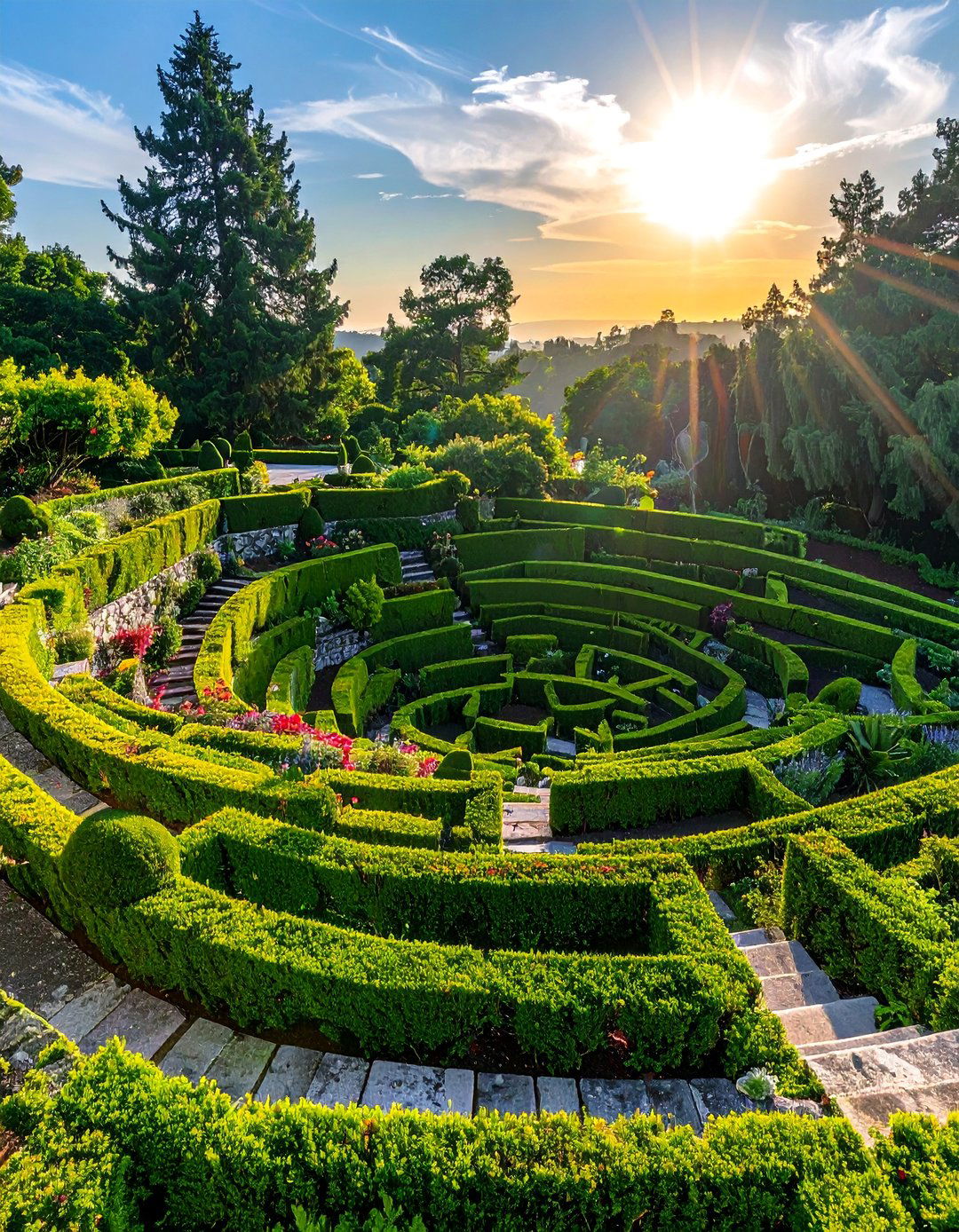
A sunken parterre garden adds an element of drama and intimacy to the landscape by being set lower than the surrounding ground level. This change in elevation creates a secluded, enclosed feeling and provides a unique vantage point from the upper level, allowing the intricate patterns to be fully appreciated. Retaining walls made of stone or brick define the space, and steps lead down into the formal garden. This design works wonderfully as a private courtyard or a transition between a house and the wider landscape. The sunken nature also offers some protection from wind, creating a microclimate that can benefit more delicate plants within the design.
8. Modern Geometric Parterre Garden
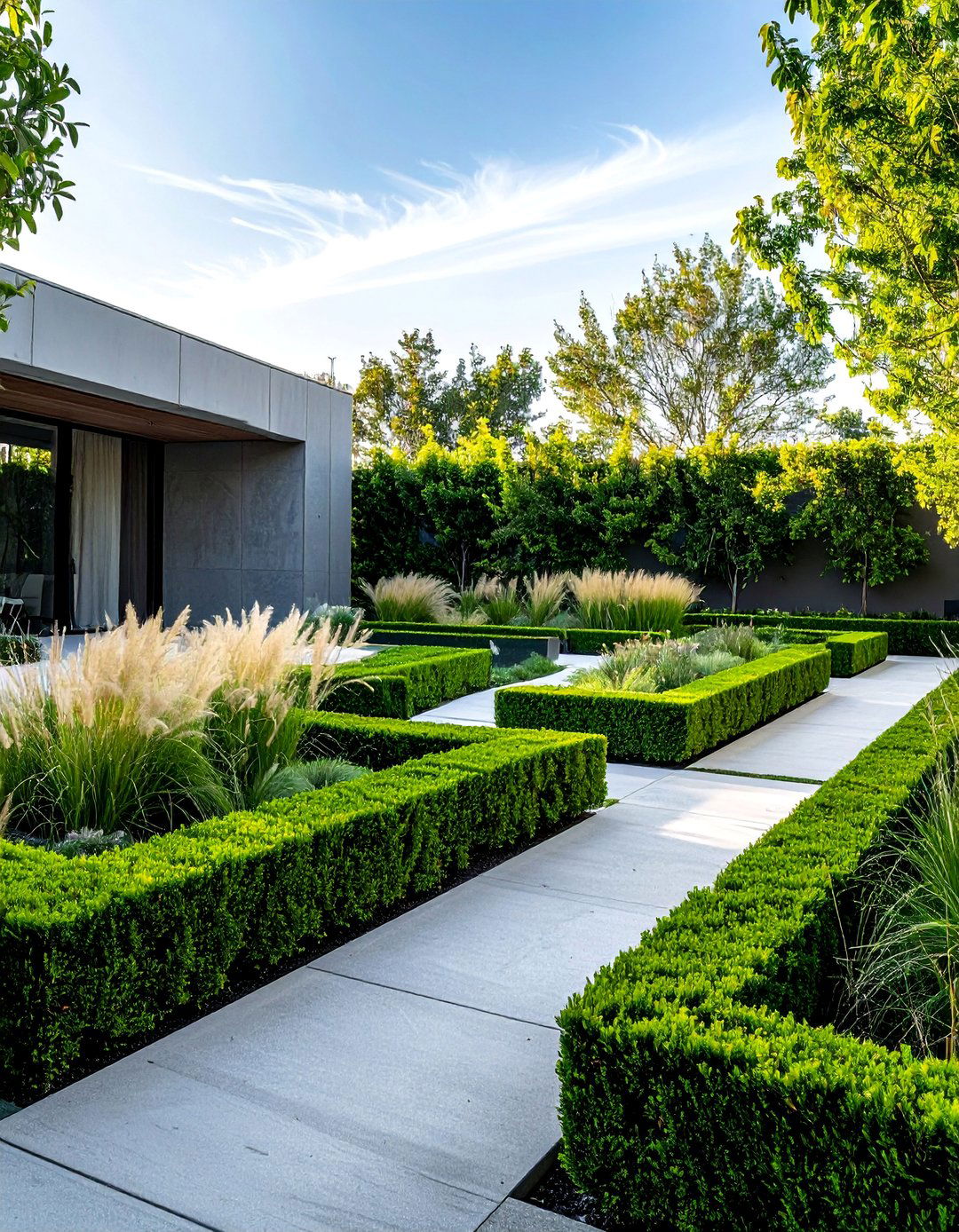
Taking a contemporary twist on a classic, the modern geometric parterre garden uses clean lines, simple shapes, and a minimalist plant palette. Instead of elaborate scrolls, this style features bold squares, rectangles, and straight lines. Hedges are still used for structure, but they are often complemented by architectural plants like ornamental grasses, succulents, or alliums. The infill might be a single type of groundcover or monochromatic gravel for a sleek, uncluttered aesthetic. This approach strips the parterre down to its essential elements of pattern and form, making it a perfect fit for modern architecture and minimalist landscape designs that prioritize structure over ornamentation.
9. Circular Parterre Garden Design
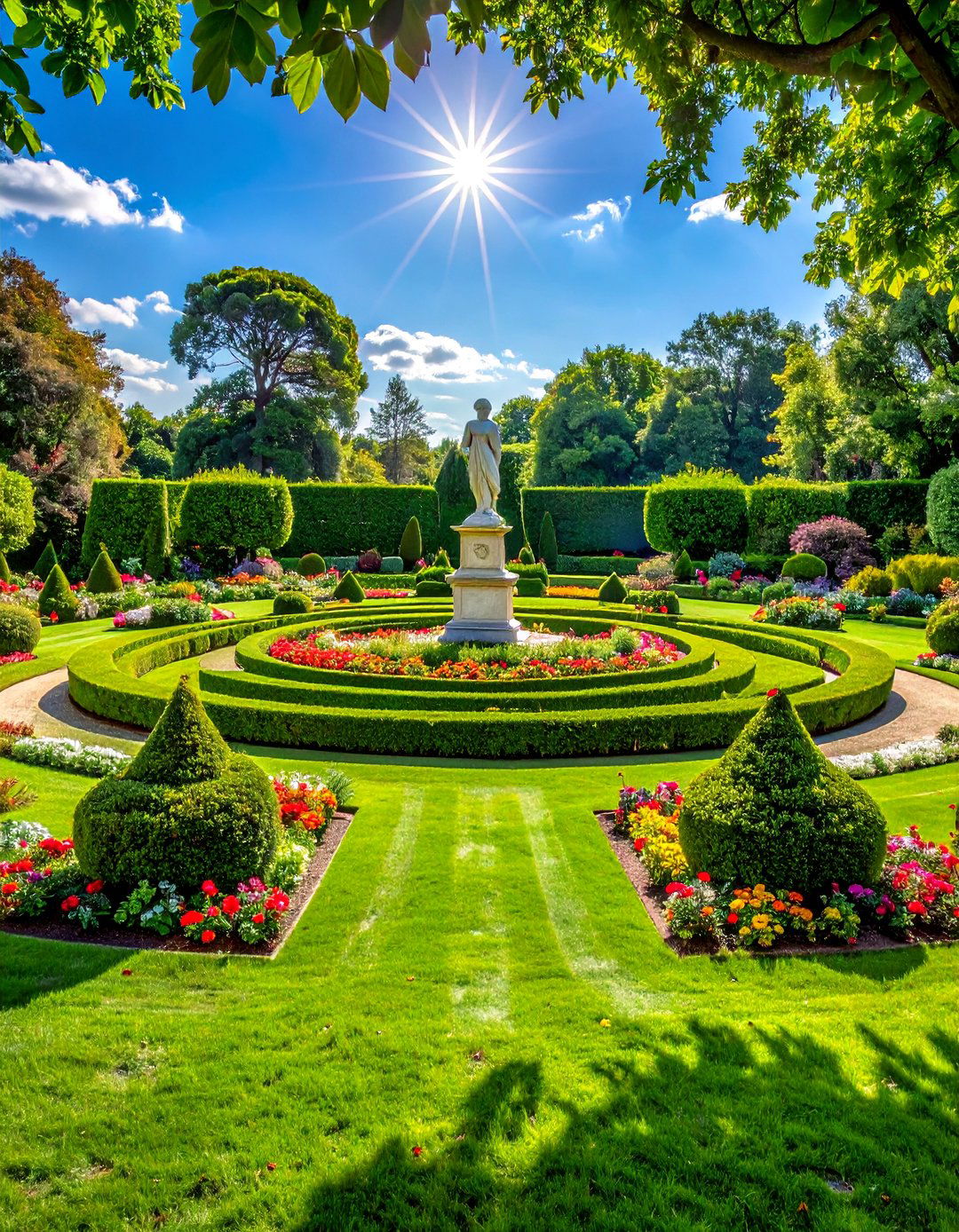
Breaking away from the traditional square or rectangular format, a circular parterre garden design creates a powerful central feature in any landscape. The design radiates outwards from a central point, which could be a fountain, a specimen tree, or a circular seating area. The hedges and paths are laid out in concentric circles or form wedge-shaped beds that emanate from the center. This creates a strong sense of movement and focus, drawing the eye inward. A circular parterre can soften the hard edges of a landscape and works beautifully as a standalone feature in a lawn or at the intersection of several garden paths.
10. Low-Maintenance Evergreen Parterre Garden

For those who love the formal look but have limited time for upkeep, a low-maintenance evergreen parterre garden is the ideal solution. This design focuses on using slow-growing, hardy evergreens for both the hedges and the infill. Dwarf conifers, heathers, and evergreen groundcovers like pachysandra can fill the beds, providing year-round texture and color with minimal care. The key is selecting plants that naturally keep their shape and require infrequent trimming. Paired with a gravel or mulch infill, this approach significantly reduces weeding, watering, and pruning, delivering the timeless elegance of a parterre without the intensive labor.
11. Four-Season Interest Parterre Garden

A four-season interest parterre garden is thoughtfully designed to provide visual appeal throughout the entire year. The structure is formed with robust evergreen hedges like boxwood or yew, which provide a green framework during winter. The beds are then planted with a succession of bulbs, perennials, and annuals that offer changing colors and textures with each season. Spring might feature tulips and daffodils, summer could showcase vibrant annuals or perennials like lavender, autumn could highlight ornamental grasses and sedums, and winter reveals the bare, elegant structure decorated with frost. This ensures the garden is never dull and remains a dynamic feature of the landscape.
12. Courtyard Parterre Garden
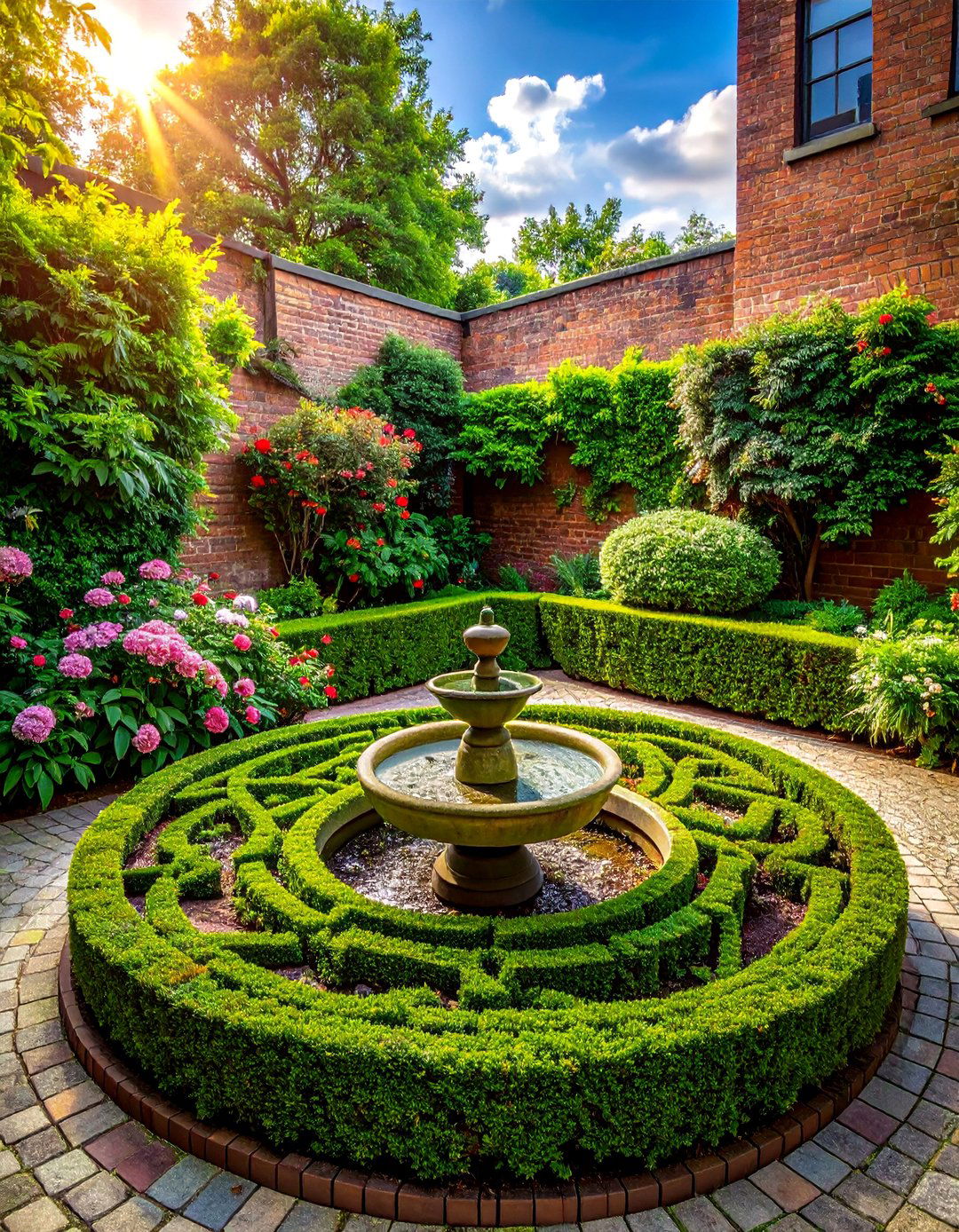
Even the smallest of spaces can accommodate a courtyard parterre garden, transforming a confined area into an elegant outdoor room. By scaling down the patterns and using dwarf plant varieties, you can create a beautiful formal design within a patio or enclosed courtyard. The geometric layout brings a sense of order and spaciousness to the area. Often, these designs incorporate a small central feature, like a birdbath or a large planter, to act as a focal point. This approach is perfect for urban settings, providing a green, structured oasis that can be enjoyed from inside the home, adding a touch of classic grandeur to a compact space.
13. Water Feature Parterre Garden

Integrating a water feature into a parterre garden elevates the design by adding the elements of sound, movement, and reflection. The formal layout can be designed around a central fountain, a reflective pool, or a series of small, interconnected rills. The geometric beds of clipped hedges frame the water, creating a harmonious and serene atmosphere. The sound of trickling water adds a soothing sensory experience, while the reflection of the sky and surrounding plants in a pool can make the garden feel larger and more dynamic. This combination of structured planting and flowing water results in a truly luxurious and tranquil garden space.
14. Monochromatic Planting Parterre Garden

A monochromatic planting parterre garden creates a sophisticated and powerful visual impact by using a single color palette. While the structural hedges provide the green framework, the interior beds are filled with flowers and foliage of varying shades and tints of one color, such as all white, blue, or purple. This approach emphasizes texture and form, as the eye is not distracted by multiple colors. For example, a white garden could feature white roses, lilies, and silver-leafed plants like lamb's ear. The result is a serene, cohesive, and elegant design that feels both modern and timeless, proving that you don't need a rainbow of colors to create a stunning effect.
15. Colorful Flower-Filled Parterre Garden

For a vibrant and joyful take on the formal parterre, a colorful flower-filled parterre garden is an excellent choice. This design uses the traditional clipped hedge structure as a container for an exuberant display of colorful flowers. The geometric beds are densely planted with a mix of annuals and perennials, creating a tapestry of bold colors that contrast beautifully with the formal green hedges. You can create complex color schemes, with each compartment featuring a different hue, or mix them all together for a cottage-garden feel within a structured framework. This style brings a lively and dynamic energy to the landscape, celebrating color in an organized fashion.
16. Integrated Topiary Parterre Garden
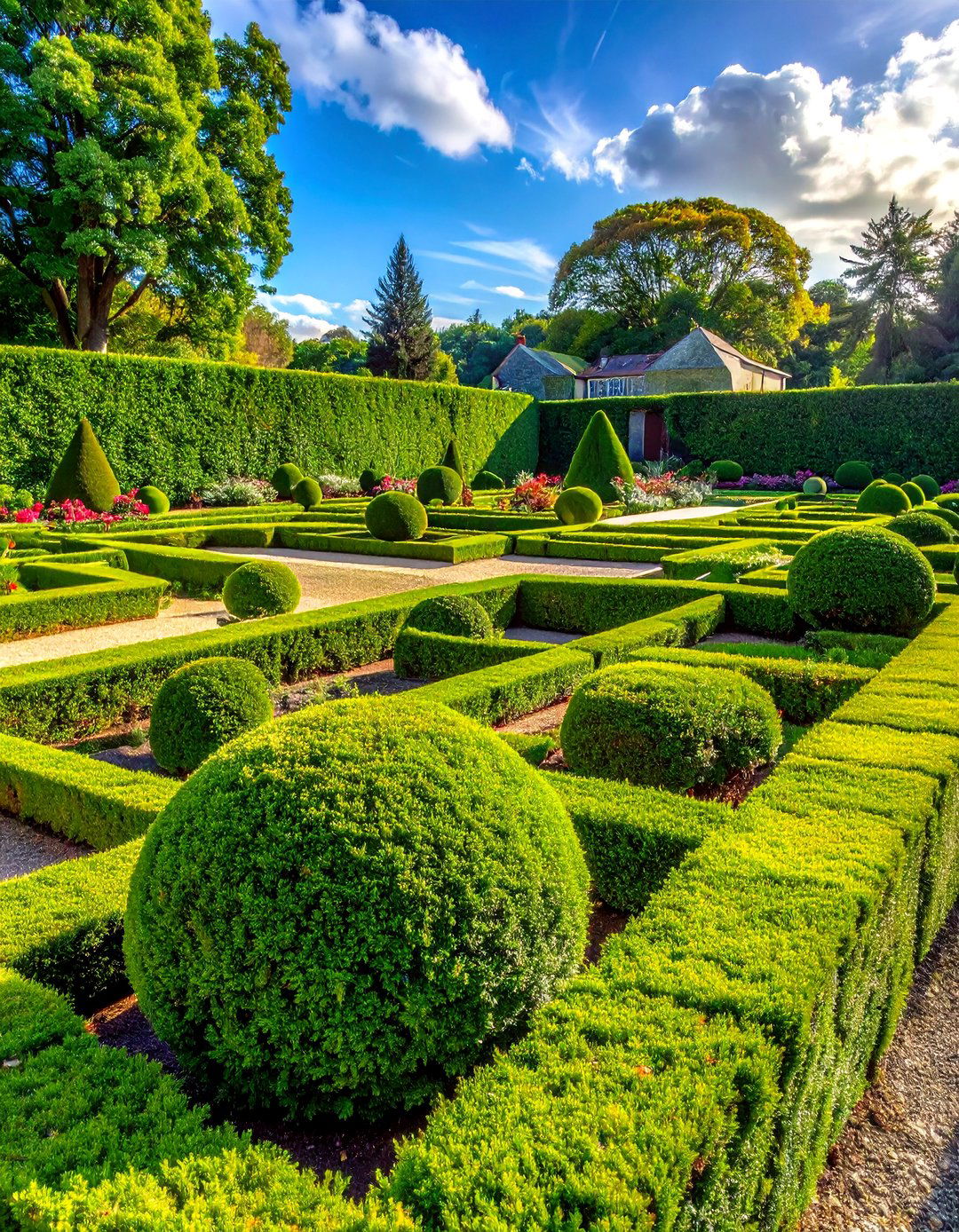
An integrated topiary parterre garden enhances the formal design by adding sculptural, three-dimensional elements. Within the flat plane of the geometric beds, taller, clipped topiary shapes like cones, spirals, or spheres are placed at key intersections or as central features within each compartment. These topiaries add height, rhythm, and a touch of whimsy to the design, creating focal points and breaking up the uniformity of the low hedges. Using the same plant material as the hedges, such as boxwood or yew, ensures a cohesive look. This combination of two-dimensional patterns and three-dimensional sculptures results in a highly architectural and visually engaging garden.
17. Terrace Parterre Garden

A terrace parterre garden is specifically designed to be viewed from above, making it perfect for properties with slopes or multiple levels. The garden is constructed on a leveled terrace, often supported by a retaining wall, which provides a natural stage for the intricate patterns. When viewed from a higher terrace, a balcony, or a window, the geometric design is revealed in its entirety, like a living carpet laid out below. This approach takes full advantage of a challenging topography, turning a steep slope into a stunning landscape feature. The clear, unobstructed view from above makes the precision of the parterre patterns even more impactful.
18. Labyrinth or Maze Parterre Garden

For a playful and interactive design, consider a labyrinth or maze parterre garden. While a traditional maze has multiple paths and dead ends, a labyrinth has a single, non-branching path that leads to the center. Both can be created using low, clipped hedges to define the walkways. This type of parterre invites exploration and offers a unique, immersive experience. The paths can be made of turf, gravel, or brick. It’s a design that engages visitors on a different level, transforming the garden from something to be viewed into something to be walked through and experienced, adding an element of mystery and fun to the landscape.
19. Formal Driveway Parterre Garden
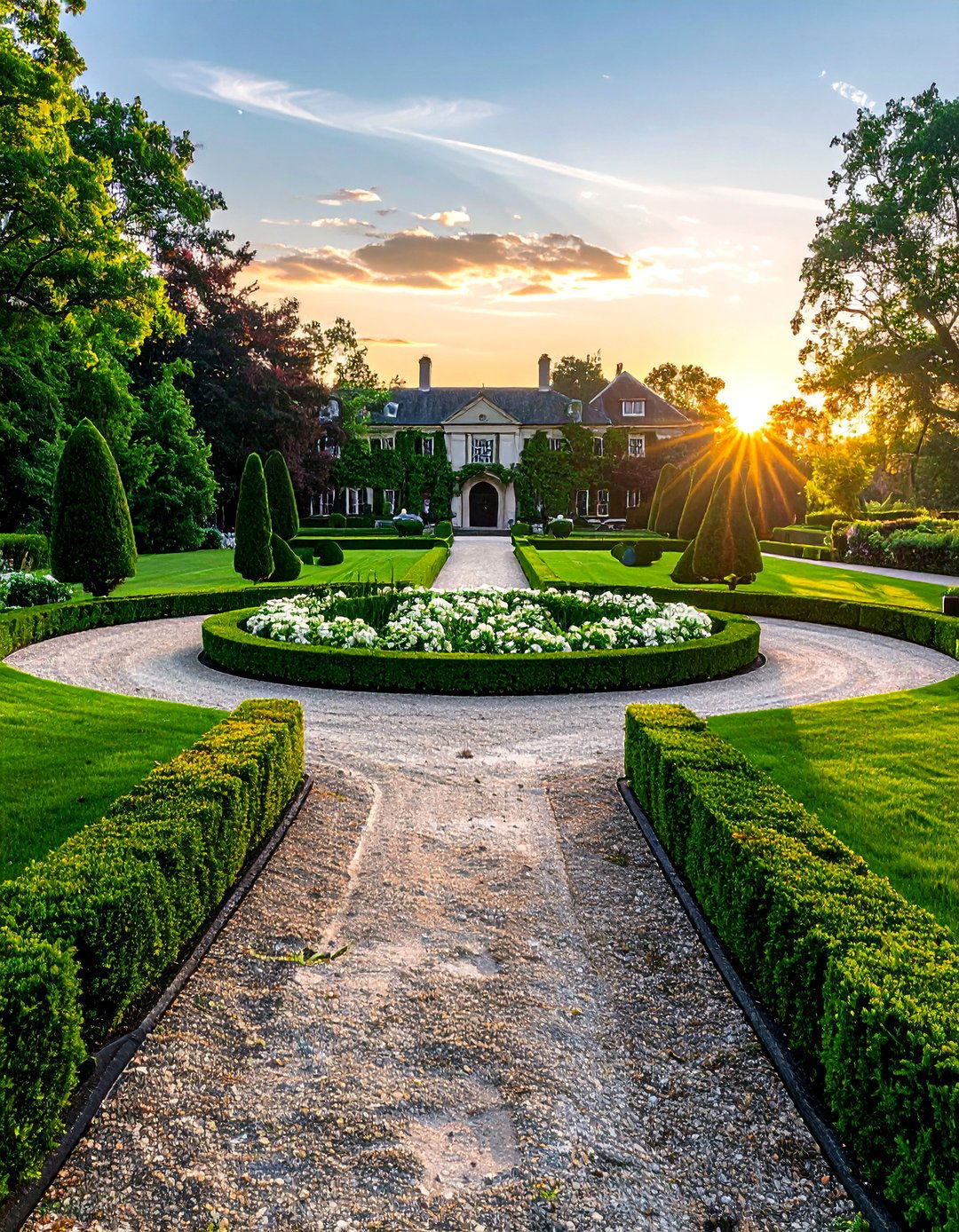
Creating a formal driveway parterre garden makes a stunning first impression and adds a sense of grandeur to the entrance of your home. Low, geometric parterre beds can be designed to flank the driveway or fill a central island in a circular drive. The patterns should be simple and bold to be appreciated from a moving car. Using robust, low-maintenance evergreens and gravel infill ensures the design looks pristine year-round with minimal upkeep. This approach elevates a purely functional space into a significant landscape feature, setting a tone of elegance and order from the moment visitors arrive at the property.
20. Miniature or Tabletop Parterre Garden
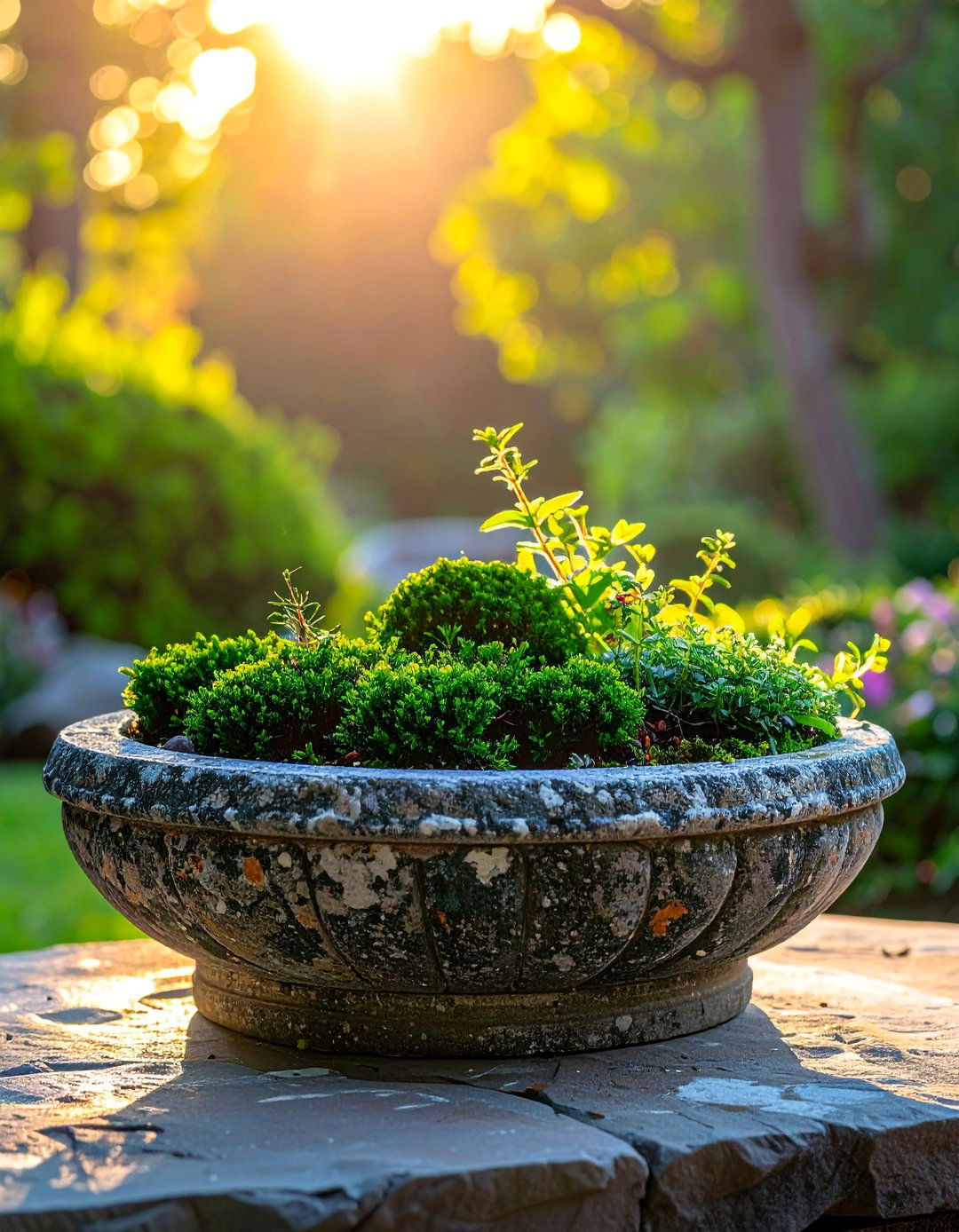
You don't need a large yard to enjoy the beauty of a parterre; a miniature or tabletop parterre garden allows you to capture the essence of this style on a small scale. Using a large, shallow container, trough, or a small raised bed, you can create a tiny, intricate parterre. Dwarf and miniature plants like dwarf boxwood, thyme, or small succulents are used to form the hedges and fill the beds. These small-scale creations are perfect for patios, balconies, or even as a unique centerpiece. They require careful trimming and attention to detail but offer a charming and accessible way to engage with formal garden design.
21. Wildflower Meadow Parterre Garden
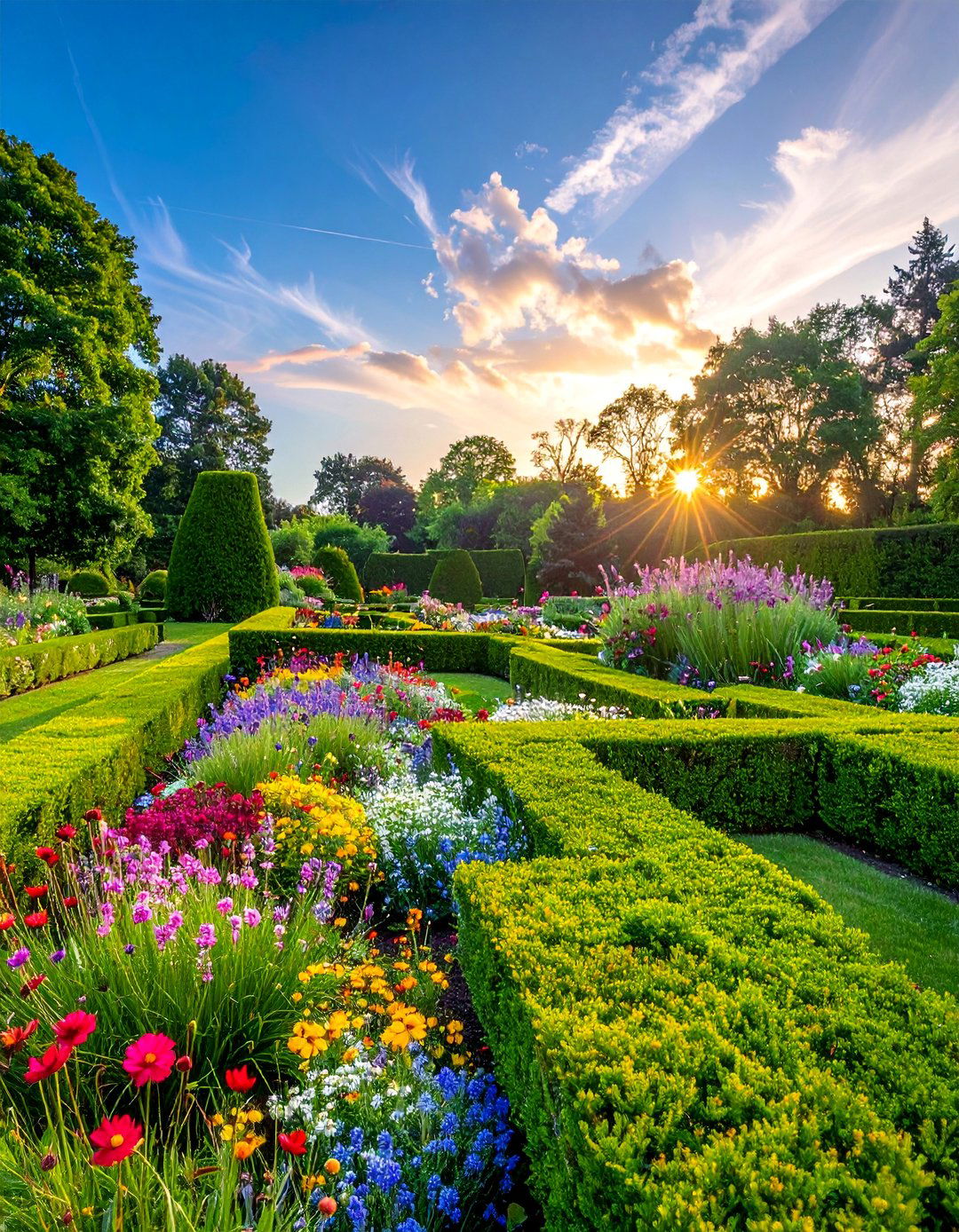
A wildflower meadow parterre garden offers a beautiful contrast between formal structure and naturalistic planting. The design uses crisp, clipped evergreen hedges to create the traditional geometric framework. However, instead of being filled with manicured annuals or gravel, the beds are sown with a mix of native wildflowers and grasses. This juxtaposition of the wild, untamed beauty of the meadow against the rigid, formal structure of the parterre creates a stunning visual tension. It’s a design that supports pollinators and local ecosystems while maintaining a sense of order and intent, perfectly blending the formal with the informal.
22. Rock and Succulent Parterre Garden
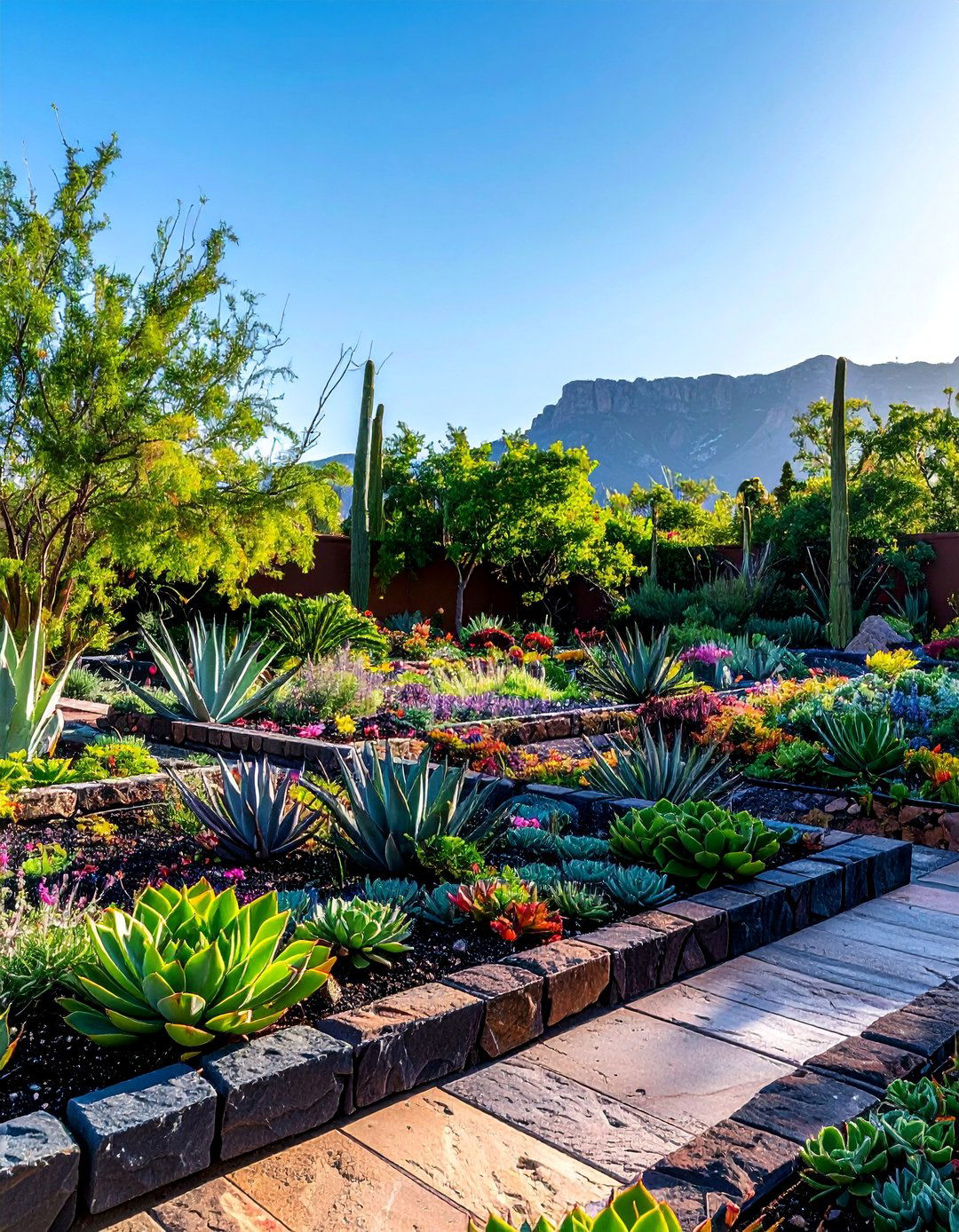
Perfect for modern homes and arid climates, a rock and succulent parterre garden combines geometric form with water-wise plants. The parterre pattern is created not with hedges, but with lines of carefully placed rocks or low metal edging. The compartments are then filled with a diverse array of succulents like echeverias, sedums, and aloes, chosen for their interesting shapes, colors, and textures. Different colored gravels can be used as a mulch to suppress weeds and add to the design. This creates a highly textural, low-maintenance, and contemporary garden that is both drought-tolerant and visually striking, offering a fresh take on the classic parterre.
23. Orchard Parterre Garden

An orchard parterre garden beautifully integrates fruit production with ornamental design. The formal parterre layout is created around espaliered or cordoned fruit trees, such as apples, pears, or figs. These trees are trained to grow flat against wires or frames, forming living fences or patterns that align with the geometric beds. The beds themselves can be underplanted with complementary herbs, flowers, or groundcovers that attract pollinators and deter pests. This design is a modern interpretation of the historic kitchen garden, combining the productivity of an orchard with the elegance of a formal parterre, creating a space that is both beautiful and bountiful.
24. Reflecting Pool Parterre Garden
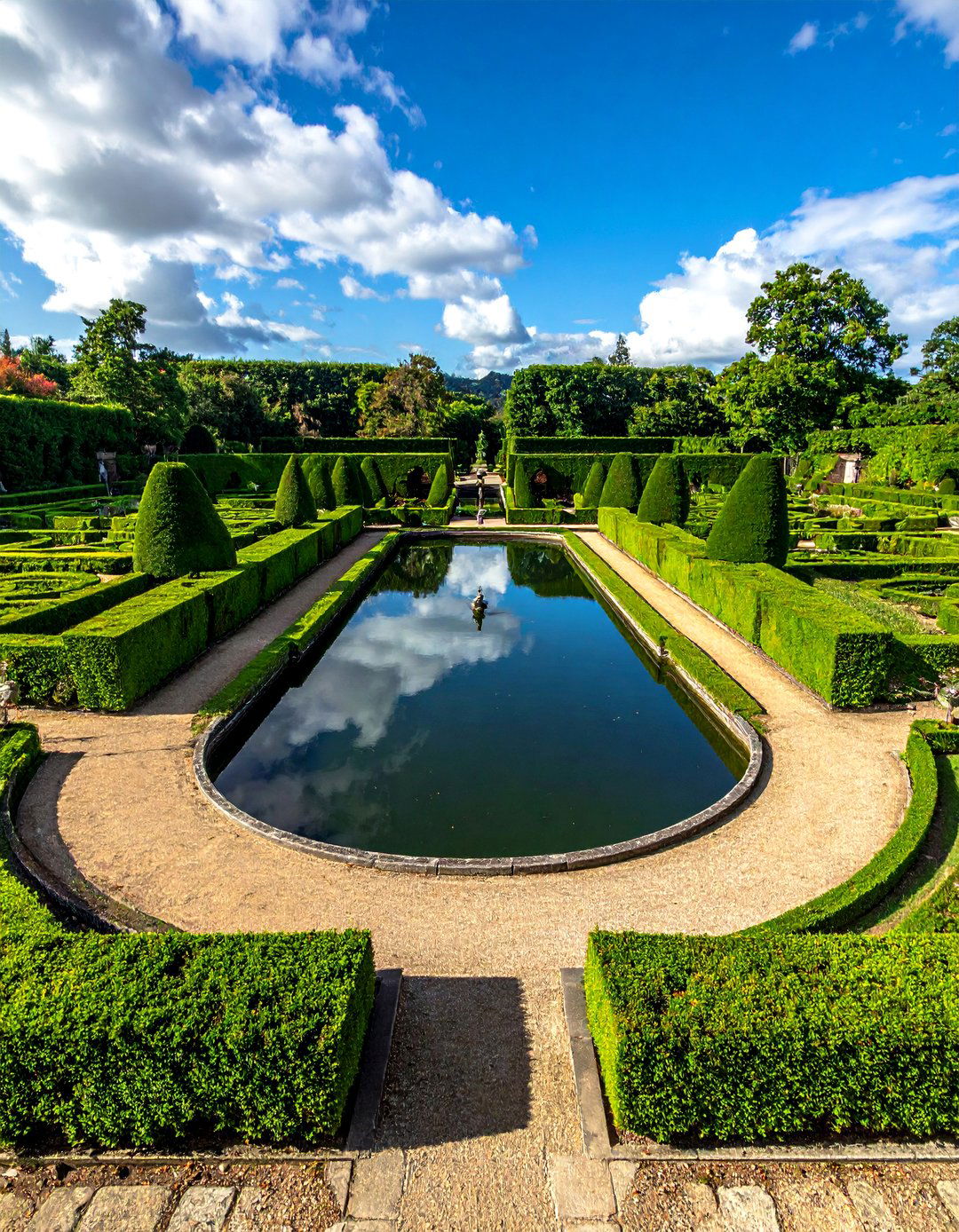
At the heart of a reflecting pool parterre garden lies a large, still body of water, designed to mirror the sky and the surrounding architecture. The parterre itself becomes a formal frame for the pool. Clipped hedges and symmetrical pathways are arranged around the water's edge, creating a simple yet profound design. The focus is not on intricate internal planting but on the powerful effect of the water and the clean lines of the framework. This creates a contemplative and serene atmosphere, where the simple geometry of the garden is enhanced by the dynamic reflections in the pool, blending the landscape with the sky in a tranquil, elegant display.
25. Grass and Topiary Parterre Garden
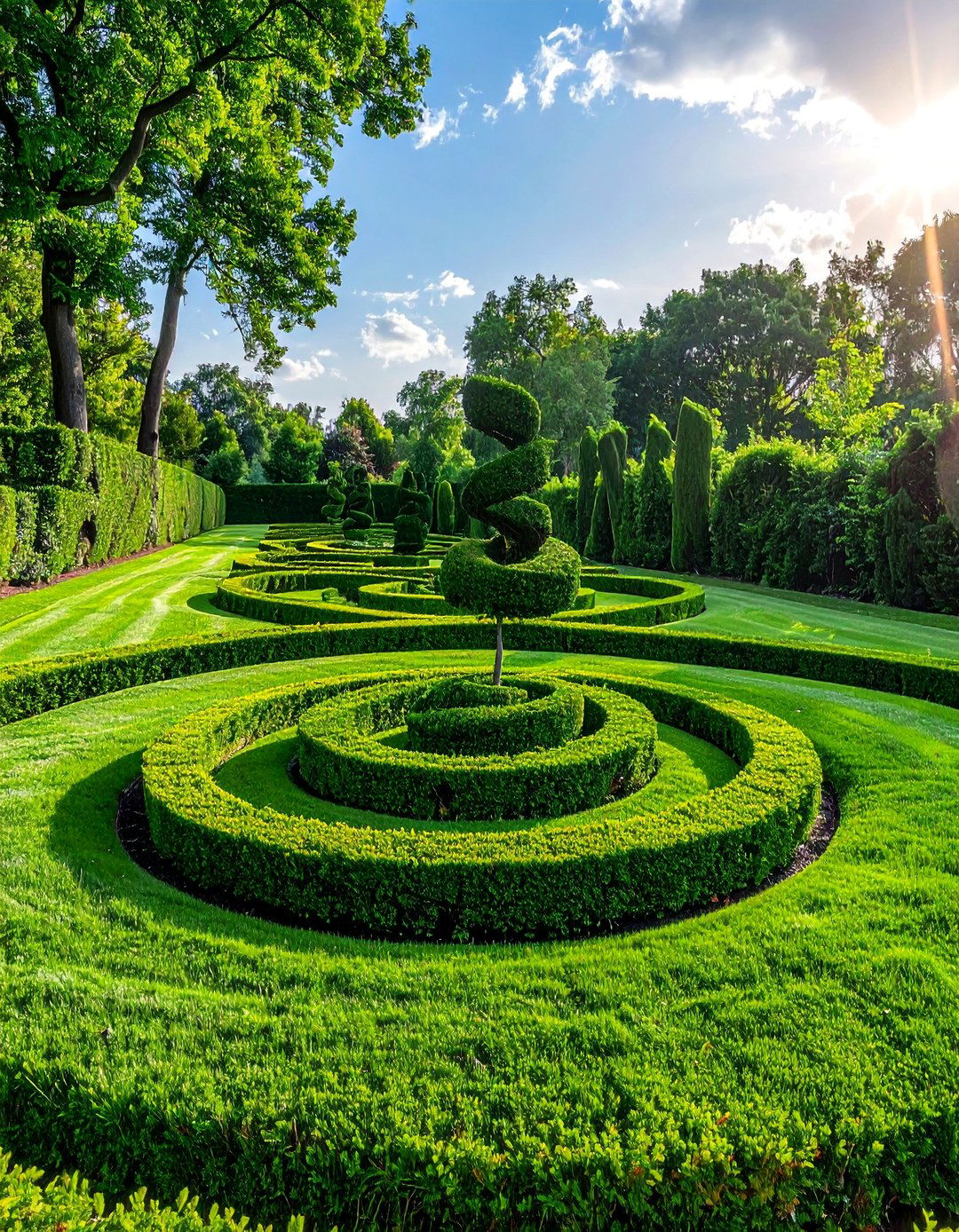
A grass and topiary parterre garden is a minimalist yet impactful design that relies on the simple contrast of green textures. The compartments of the parterre, defined by low boxwood hedges, are filled with lush, perfectly manicured turf. This creates a clean, carpet-like effect. To add vertical interest and a sense of formality, sculptural topiary forms are placed at strategic points within the design. The simplicity of the green-on-green color palette emphasizes the shapes and patterns of the hedges, turf, and topiary. This style is incredibly elegant, offering a calm and restful visual that highlights the pure geometry and horticultural skill of the garden.
Conclusion:
Parterre gardens offer an exceptionally versatile framework for elegant landscaping. From the classic French designs using boxwood and gravel to modern interpretations with succulents, edibles, or wildflowers, there is a parterre style to suit any taste and space. By focusing on symmetrical patterns, clean lines, and a structured layout, these gardens bring a timeless sense of order and sophistication to the landscape. Whether grand or miniature, intricate or simple, a well-designed parterre serves as a stunning focal point, providing year-round beauty and proving that thoughtful structure is the foundation of unforgettable garden design.

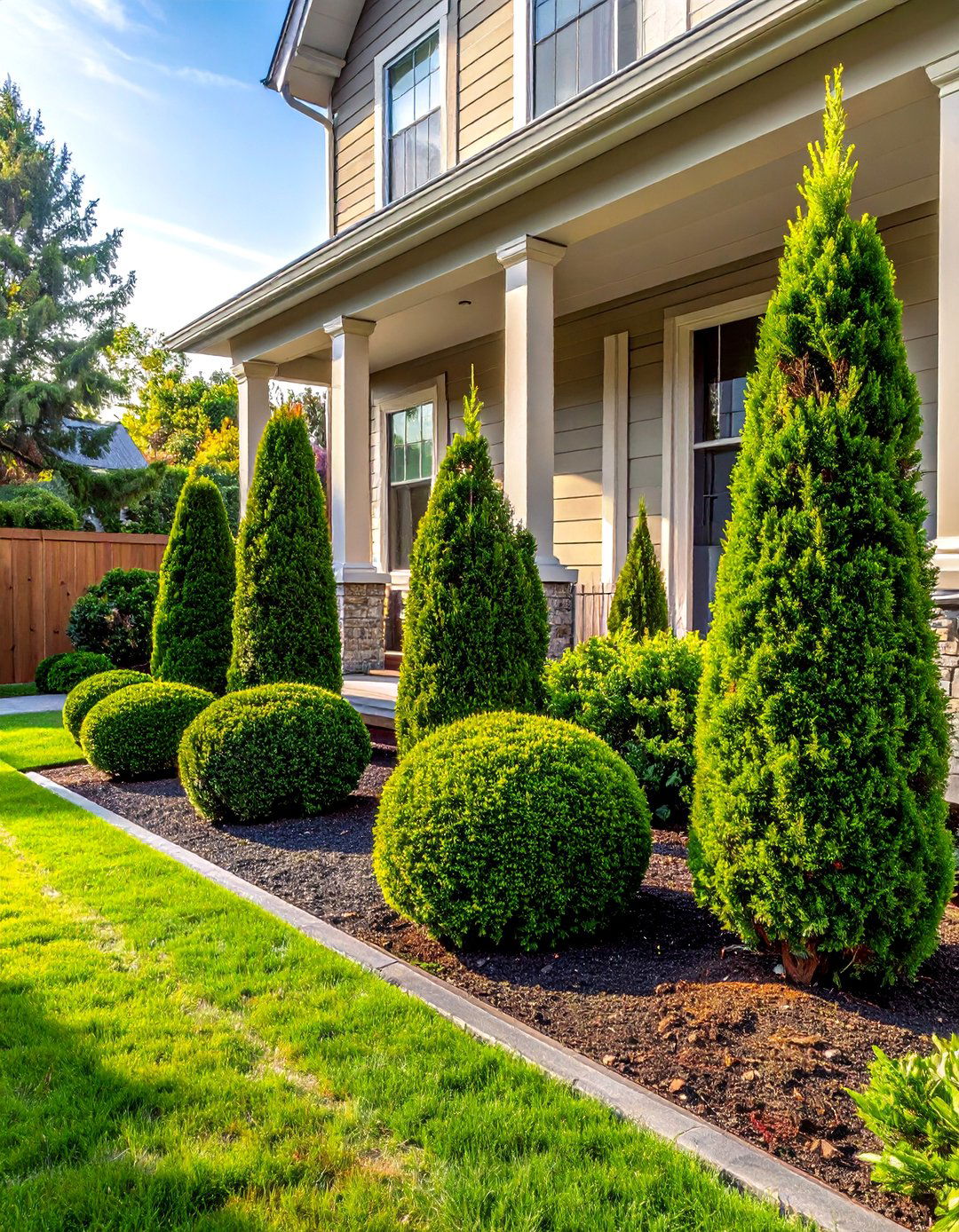
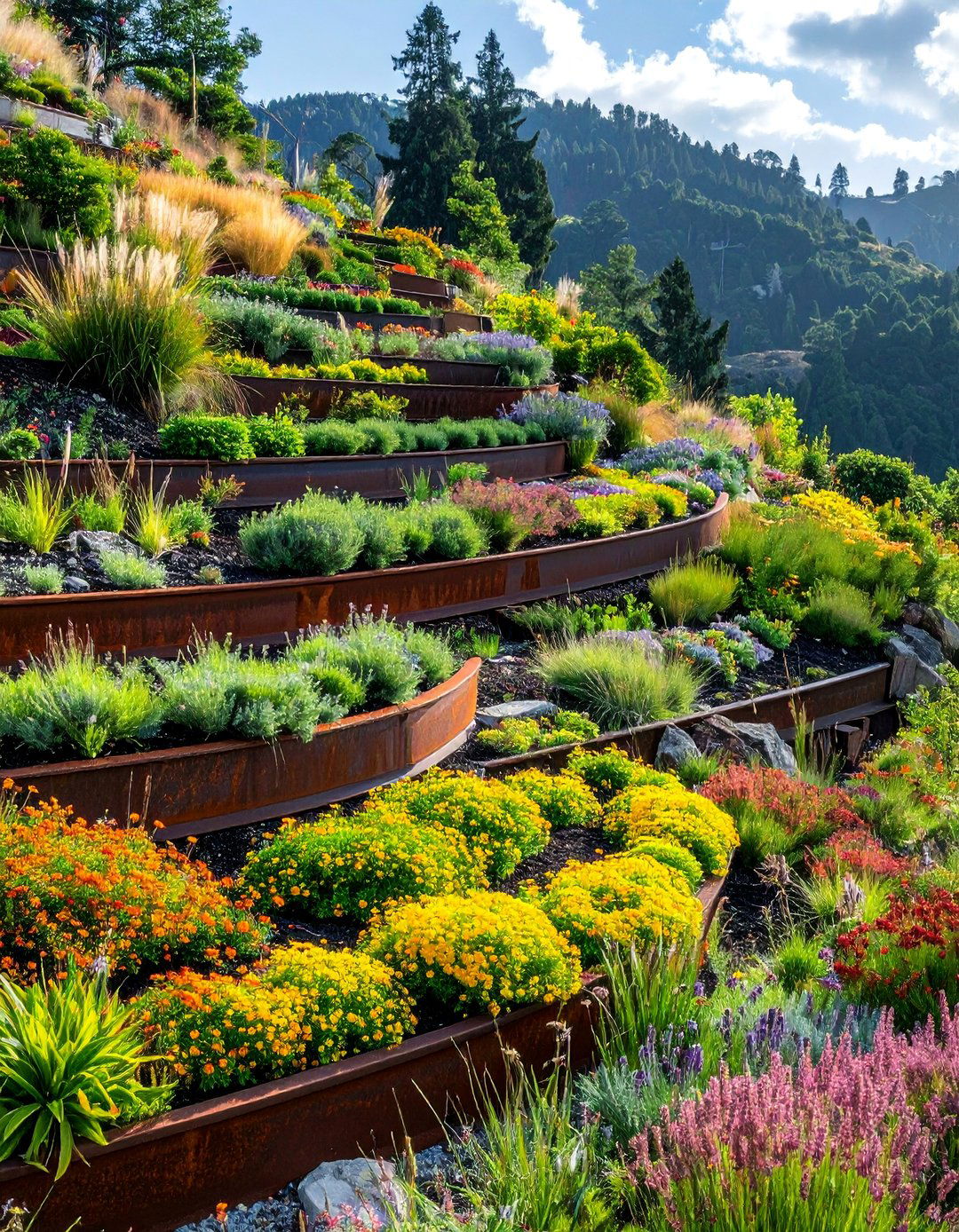
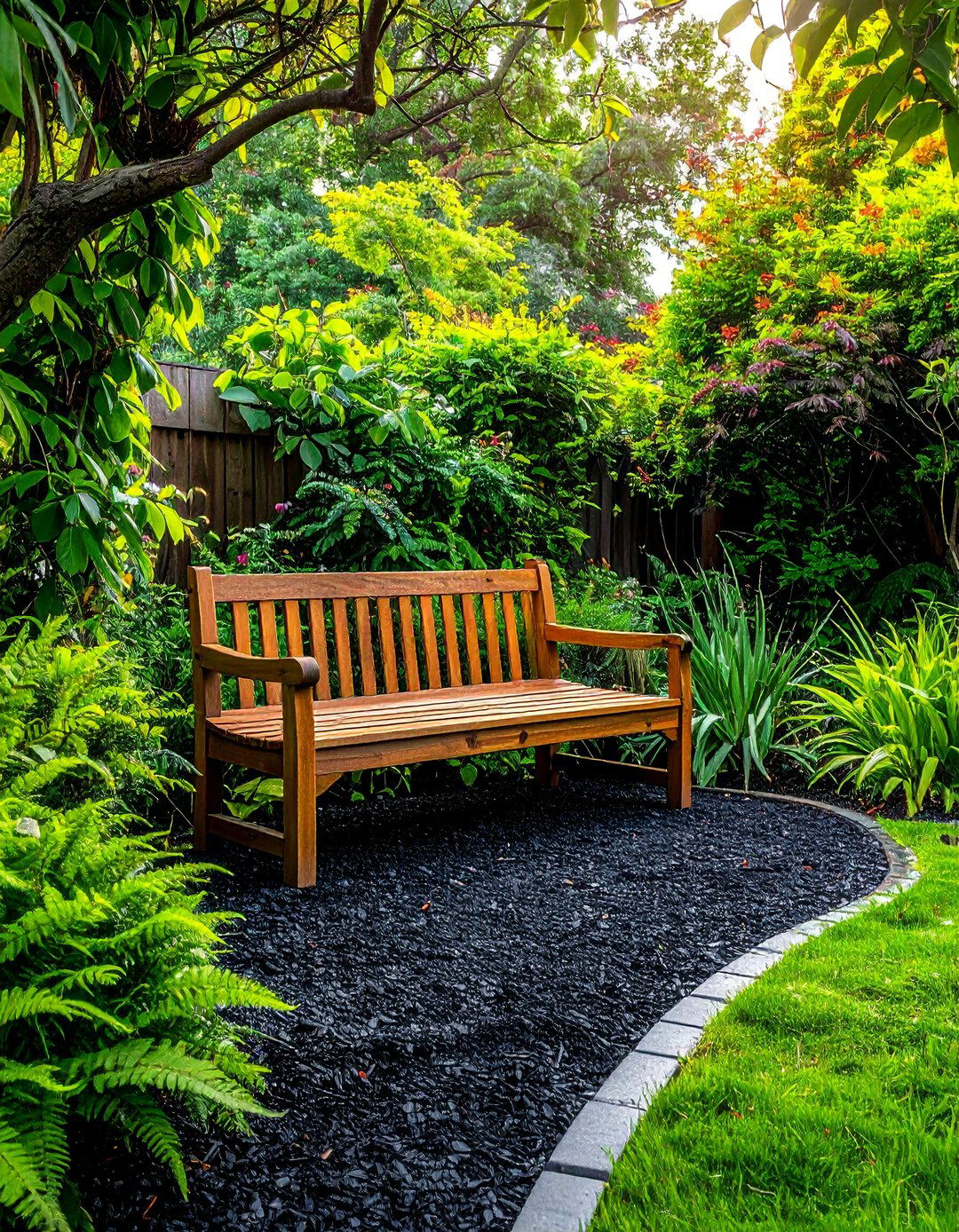
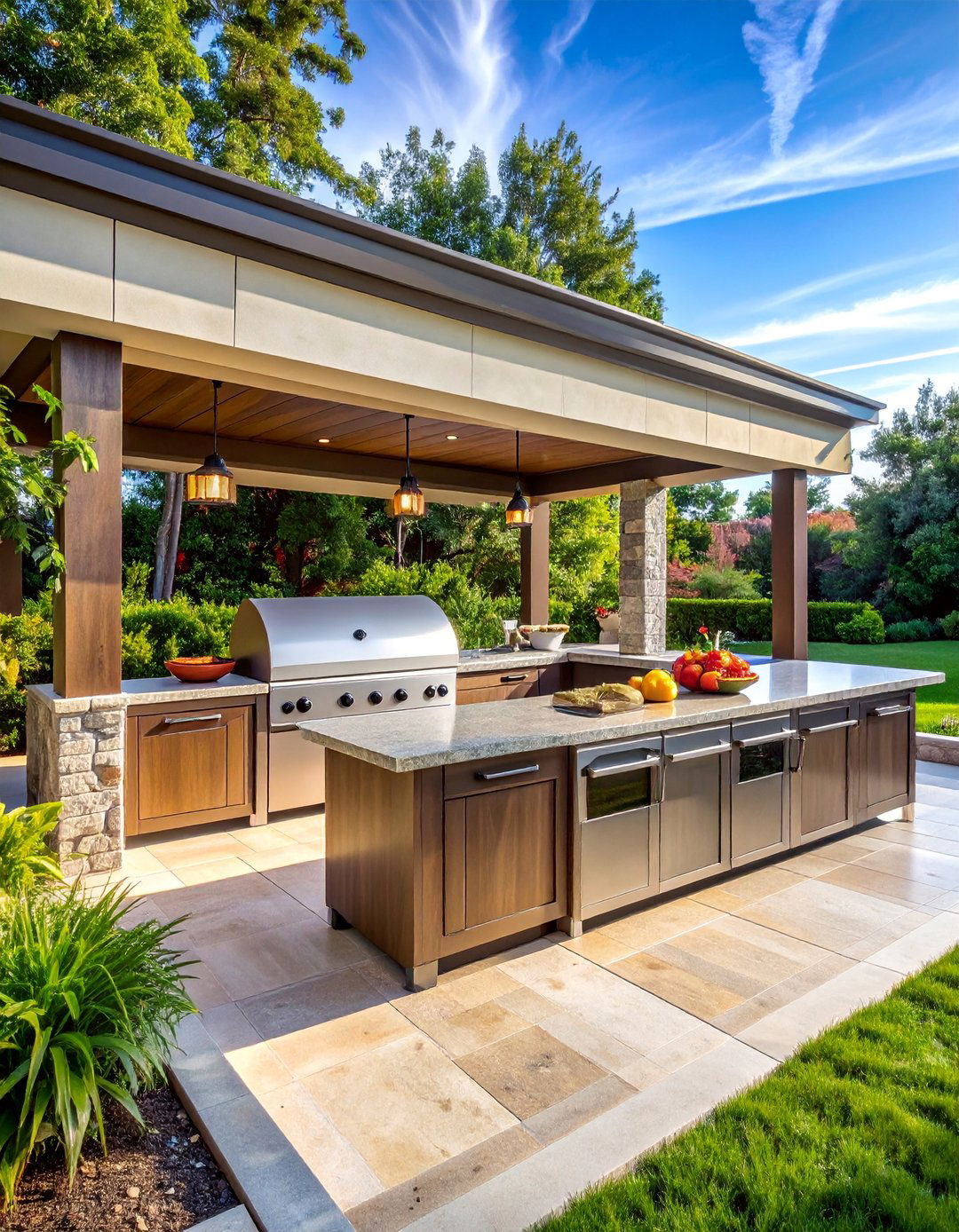
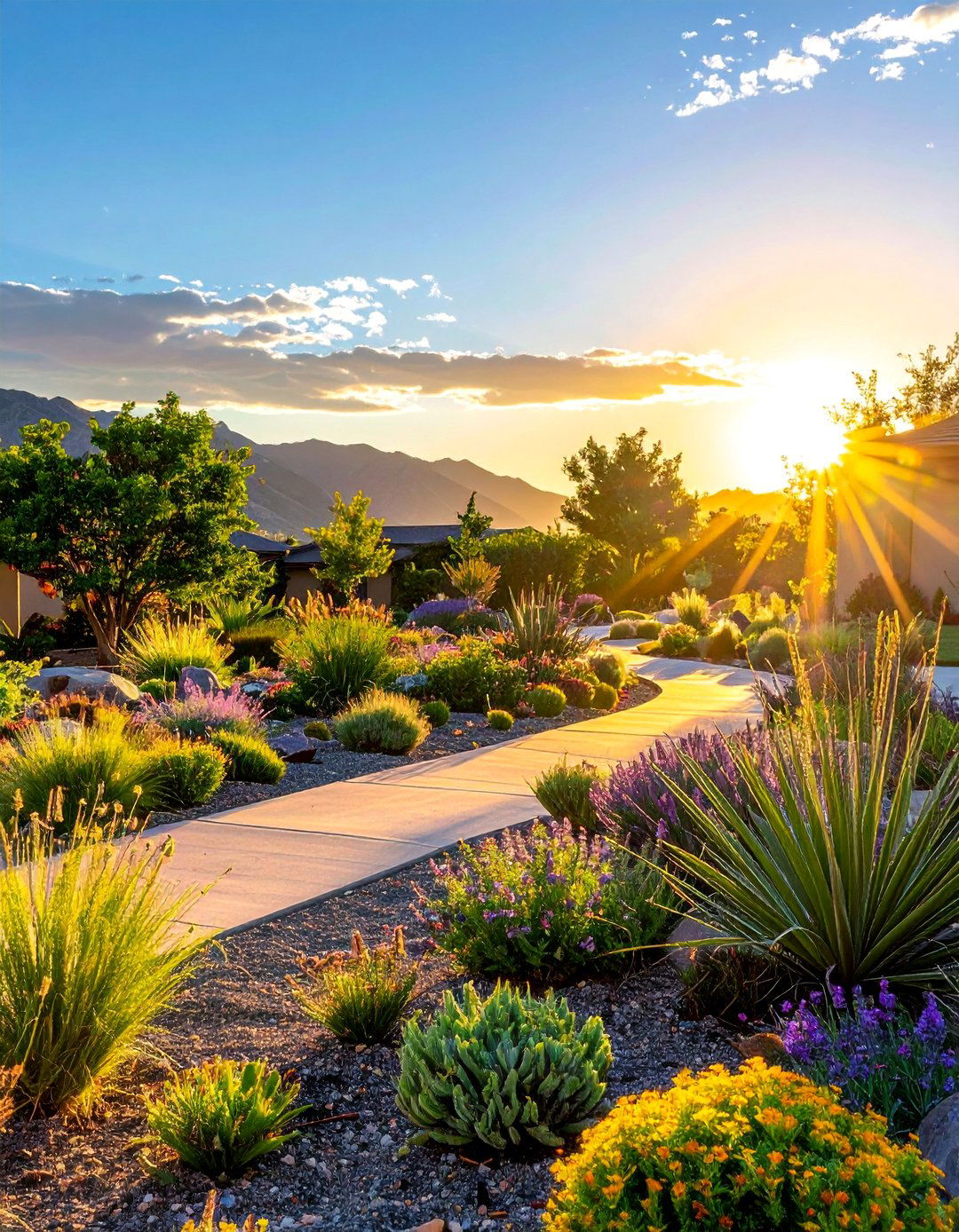
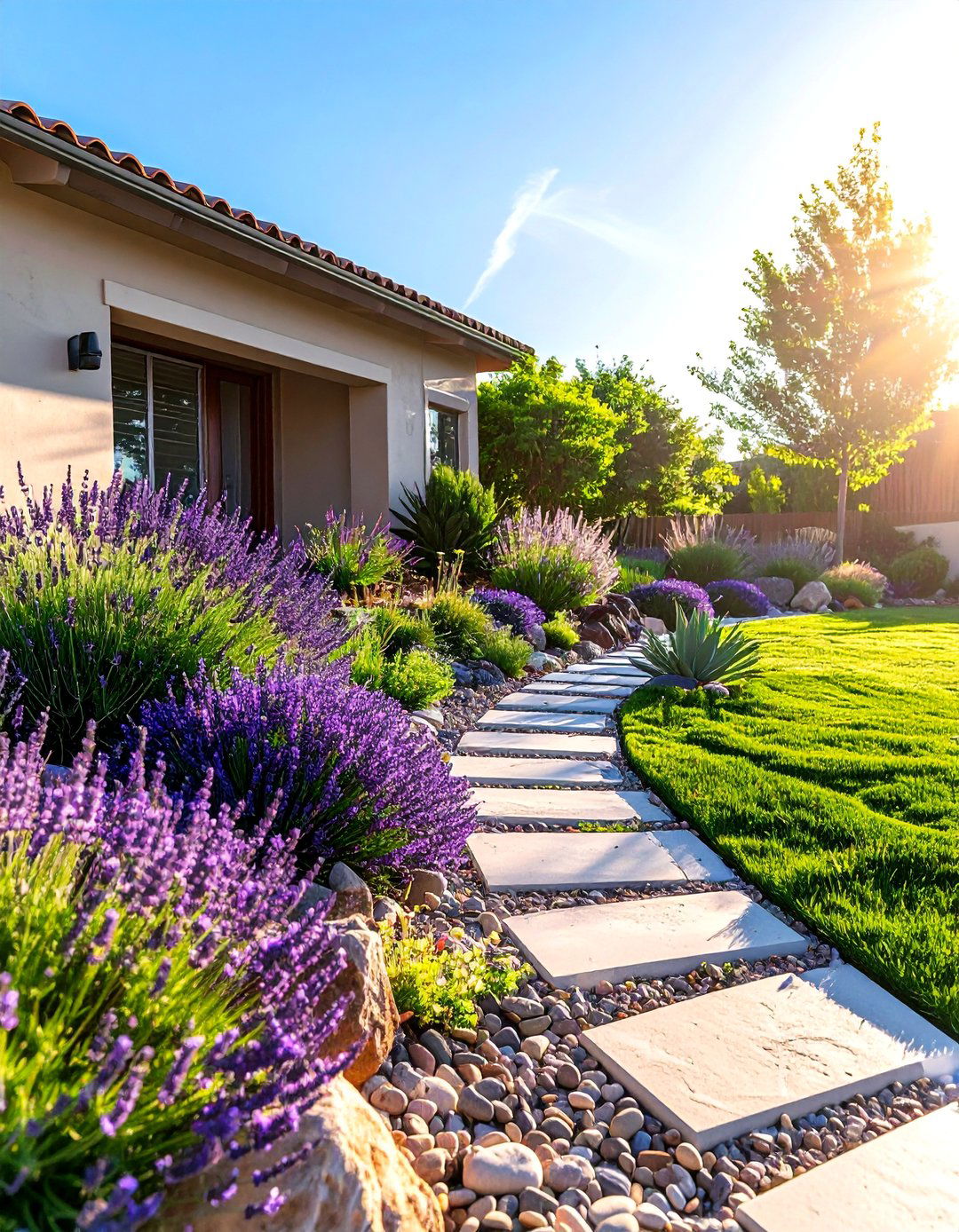
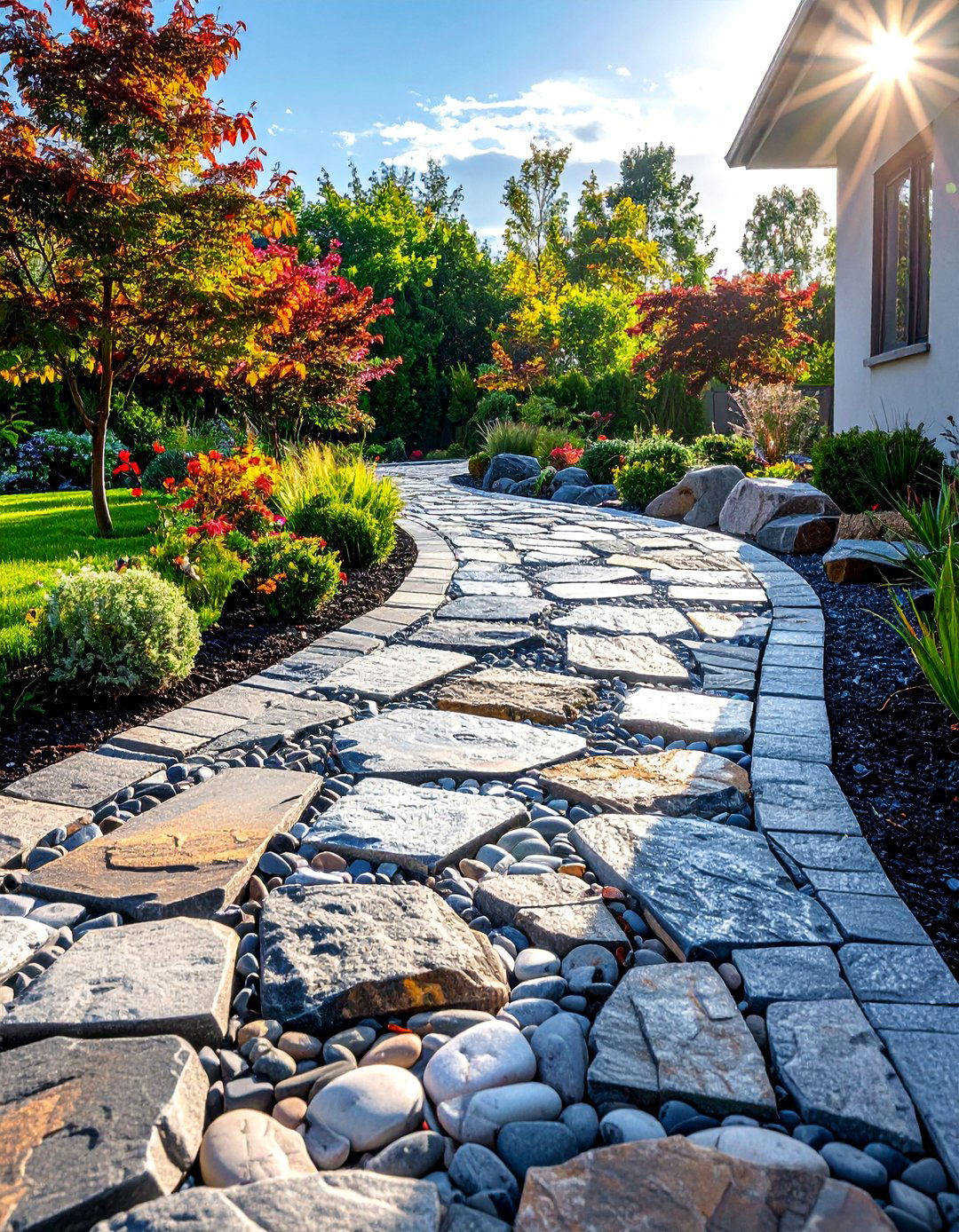
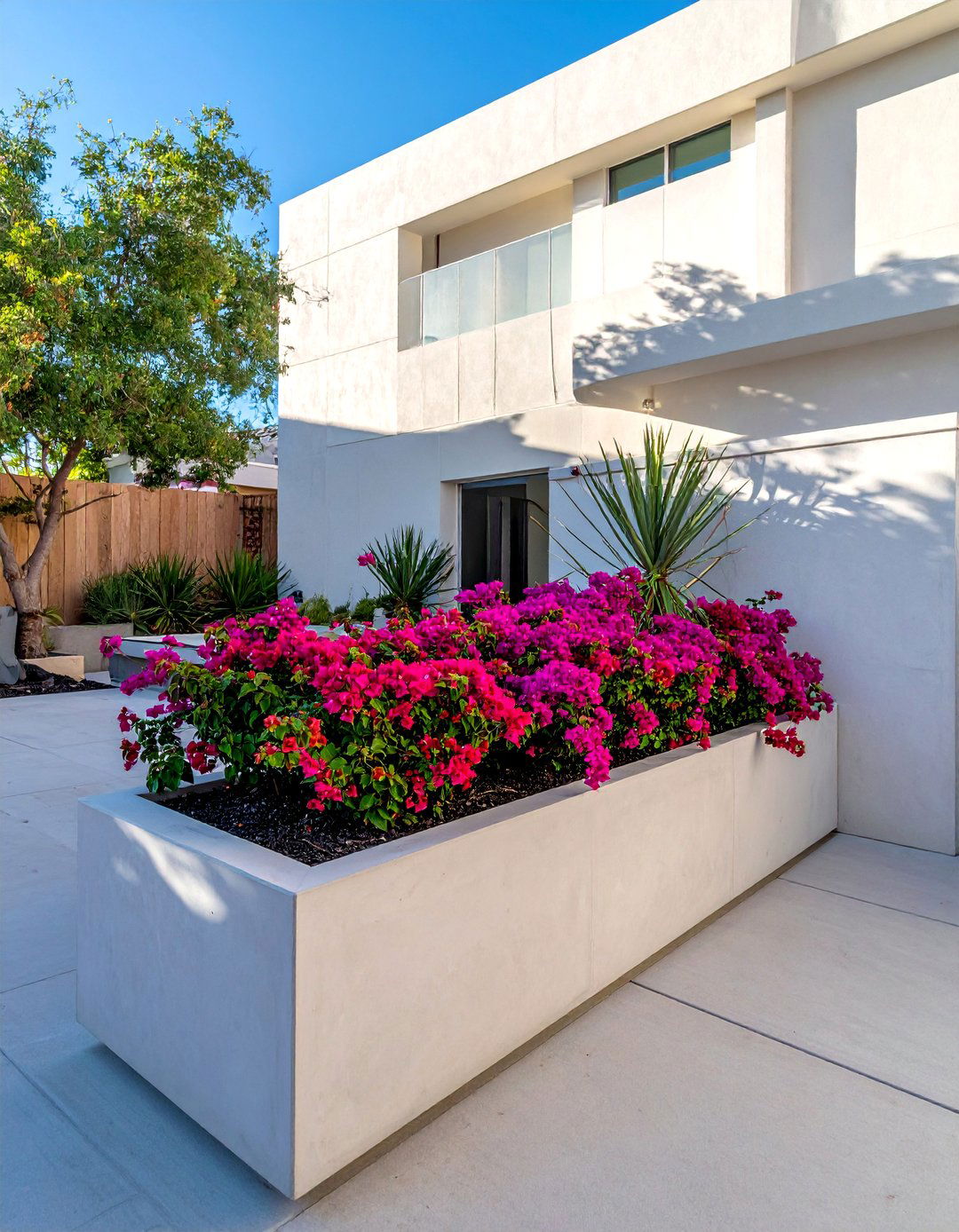
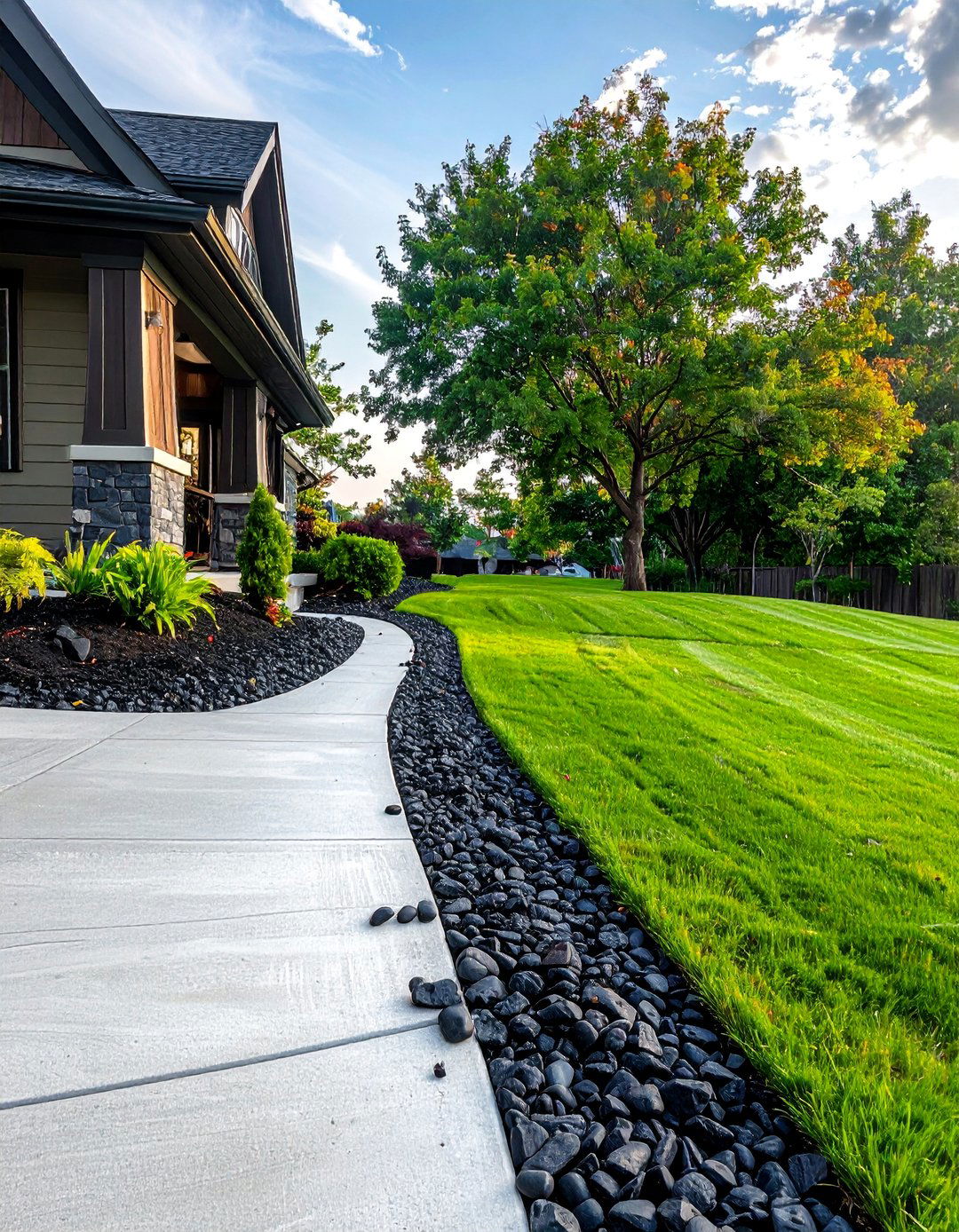
Leave a Reply